Are you getting tired of all the green in your garden? Maybe it's time to add a splash of color. One of the best things about succulents is the incredible variety of colors, so don't be afraid to be a little bold with your plants.
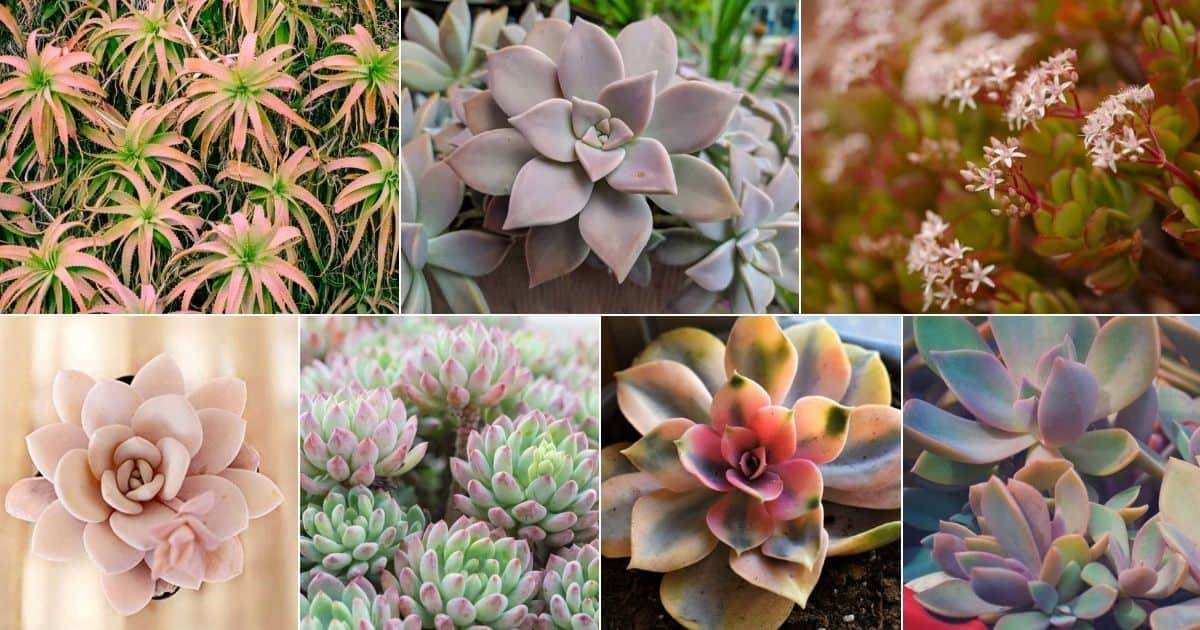
You may be used to seeing pink flowers, but what about pink plants? These pretty pink succulents are perfect for lovers of pastels. Whether you prefer a solid pink plant or just a hint of pink, you're sure to find the perfect pink plant on this list to add to your collection.
Read Related Topic: 9 Vibrant Purple Succulents
Jump to:
- Beautiful Pink Succulents
- Echeveria laui
- Pachyphytum Oviferum ‘Pink Moonstone’
- Sedeveria ‘Pink Granite’
- Sedum rubrotinctum ‘Aurora’
- Crassula ovata ‘Pink Beauty’
- Crassula pellucida ‘Variegata’ or ‘Calico Kitten’
- Echeveria ‘Perle Von Nurnberg’
- Aloe ‘Pink Blush’
- Graptopetalum paraguayense ‘Ghost Plant’
- Graptoveria ‘Douglas Huth’
- Echeveria ‘Rainbow’
- Anacampseros telephiastrum – Variegata or Sunrise
- Echeveria sp. - Can-Can
- Graptopetalum rusbyi
- Graptosedum sp. - ‘Alpenglow’
- Aeonium sp. - Pink Daisy
- Aeonium sp. - 'Pink Witch'
- Echeveria sp. - Pink Champagne
- Kalanchoe sp. - Pink Mother of Thousands or Pink Butterflies
- Anacampseros telephiastrum - Sunrise
- Callisia repens – Pink Lady Turtle Vine
- Sempervivum sp. - ‘Dame Arsac’
- Sempervivum sp. - Woolcot
- Echeveria sp. - The Rose
- Sedum sp. – Sunsparkler Wildfire
- Graptoveria sp. - Bashful
- Sempervivum sp. - Jungle Shadows
- Sempervivum sp. – Rose Queen
- Sempervivum sp. – Round Robin
- Gymnocalycium anistii var.tucavocense
- Sempervivum sp. - Magnificum
- Sempervivum sp. - Dallas
- Pleospilos nelii – Royal Flush
- Sempervivum sp. - Centennial
- Sempervivum sp. – Downland Queen
- Aloe sp. - Oik
- Sempervivum sp. - Zulu
- Echeveria sp. – Chick Charms Lotus Blossom
- FAQs About Pink Succulents
- Add Pretty Pink Succulents to Your Collection Now!
Beautiful Pink Succulents
Echeveria laui
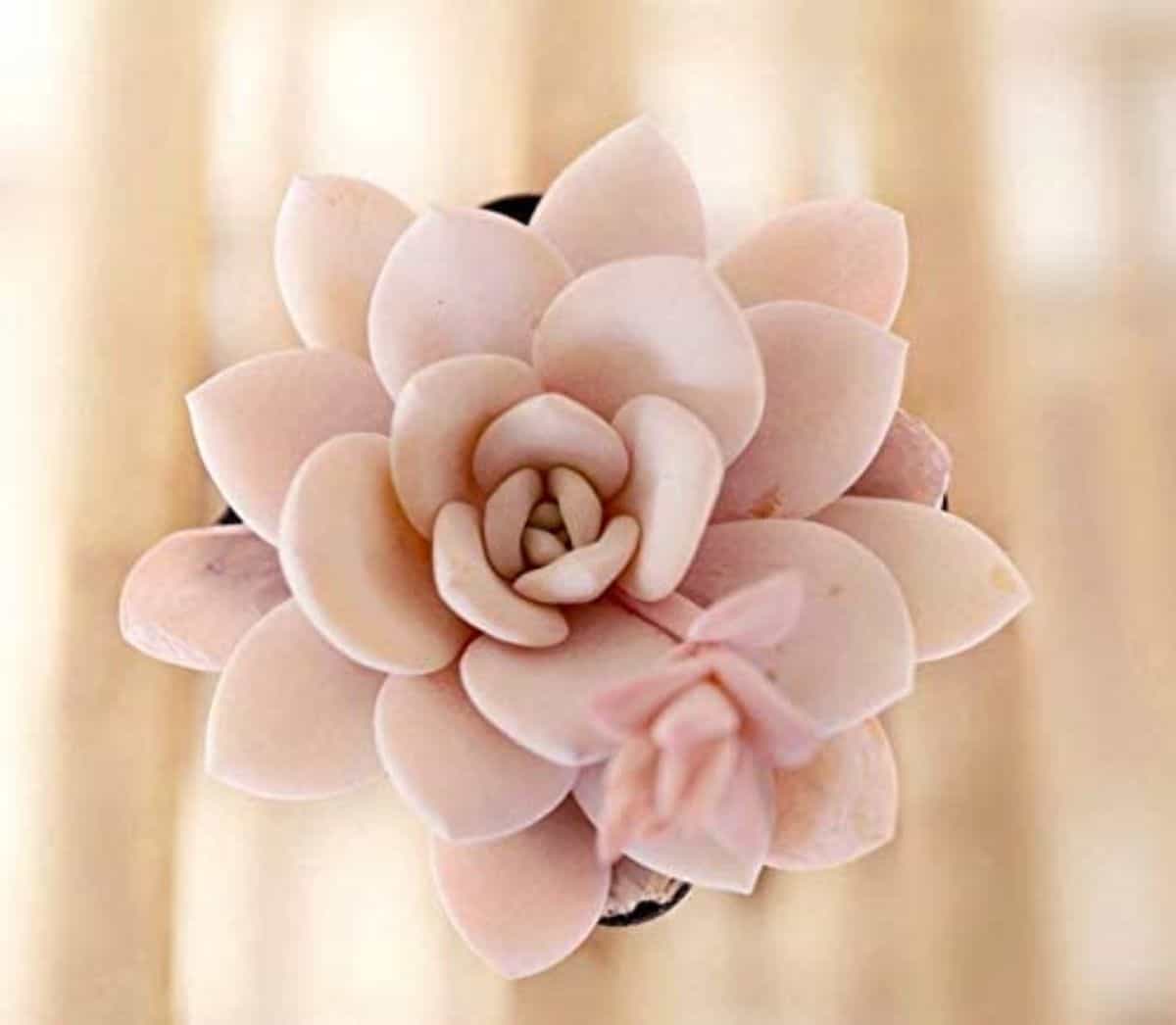
Buy it from:
This adorable little succulent is native to Oaxaca, Mexico and can grow up to six inches tall with rosettes of up to five inches in diameter. The plump leaves of the plant tend to be a grayish-blue with a hint of pink. The flowers of the plant are delicate and peachy-pink in color.
Echeveria laui prefer well-draining soil and dry conditions. In the winter, they will need to be watered less frequently than in the spring and summer. They thrive in full sun, but do not do tolerate frost well.
Read Also: 11 Best Cold Hardy Succulents
Pachyphytum Oviferum ‘Pink Moonstone’
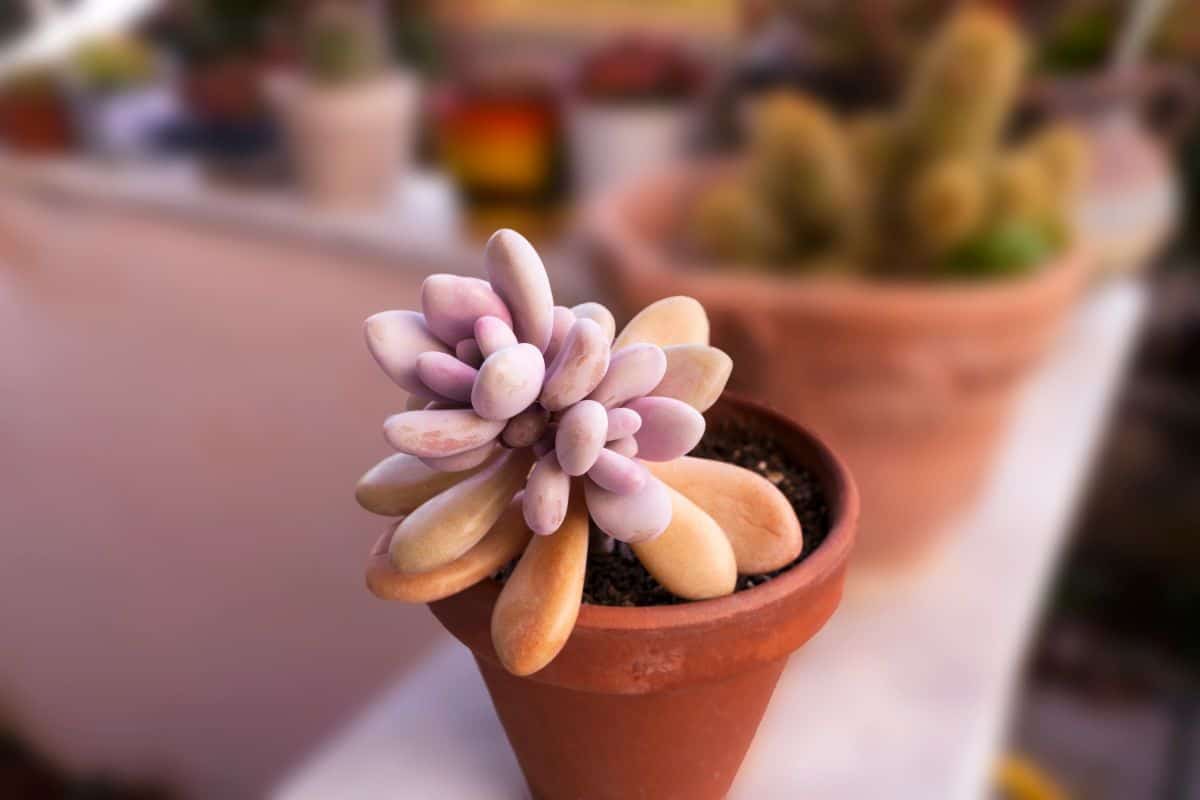
Buy it from:
Pink Moonstone is a peachy pink succulent native to Central Mexico, like Mammillaria Elongata. Though most often pinkish in color, the leaves can also range toward a bluish-lavender. The chunky leaves are coated in a white or silver film, or farina. The rosettes are quite small, typically under four inches in diameter, and the stems can grow up to eight inches in length, typically causing the plant to lie flat on the ground or trail from their container.
Pink Moonstones do best with infrequent watering and partial sun. They are not particularly frost-hardy, but they are easy to care for and easy to propagate.
Read Also: 9 Outstanding Orange Succulents
Sedeveria ‘Pink Granite’
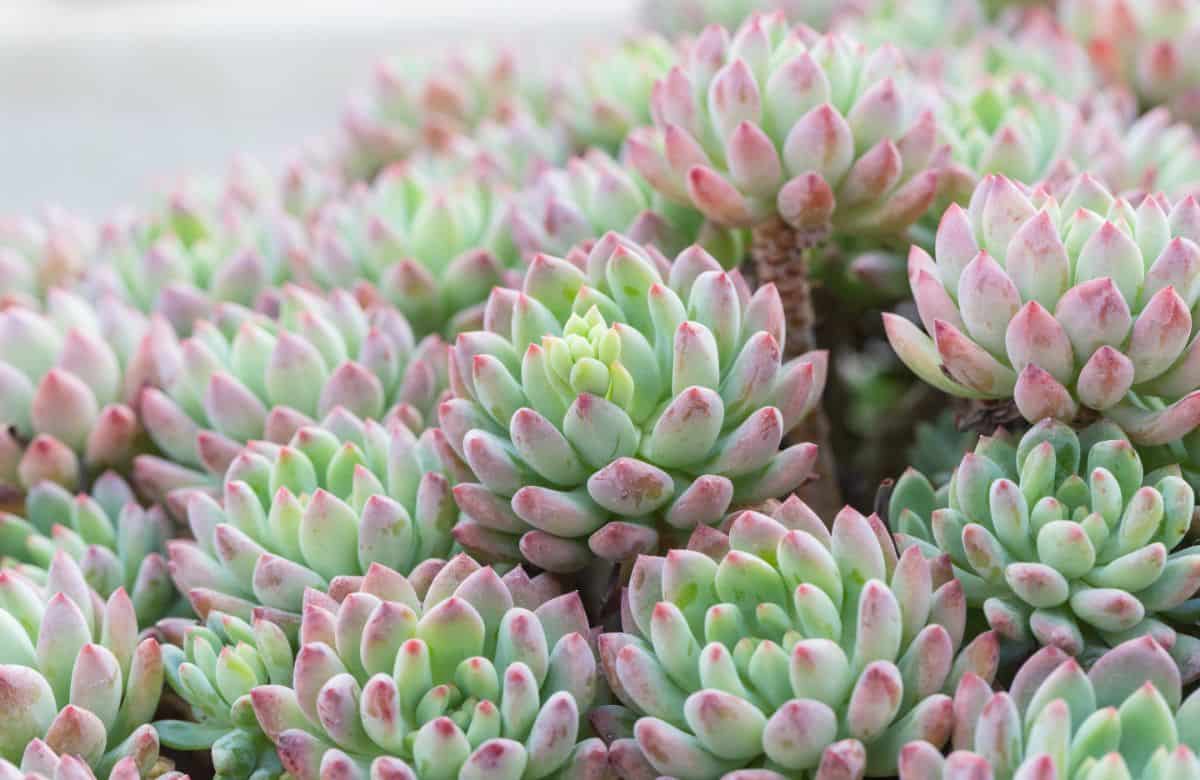
Buy it from:
This interesting little hybrid is perfect for lovers of pastel colors. It’s mint green stems and thick pink leaves compliment any gardener’s color palette. The rosettes can reach up to six inches in diameter and the stems usually reach six to eight inches tall. Like Pink Moonstone, the long stem and heavy rosette typically cause the plant to lie down or hang over the edge of their container.
Pink Granite is an easy to care for succulent. They prefer partial sun or bright indoor light. They are also pet-safe if you have any concerns about your furry friends raiding your garden.
Sedum rubrotinctum ‘Aurora’
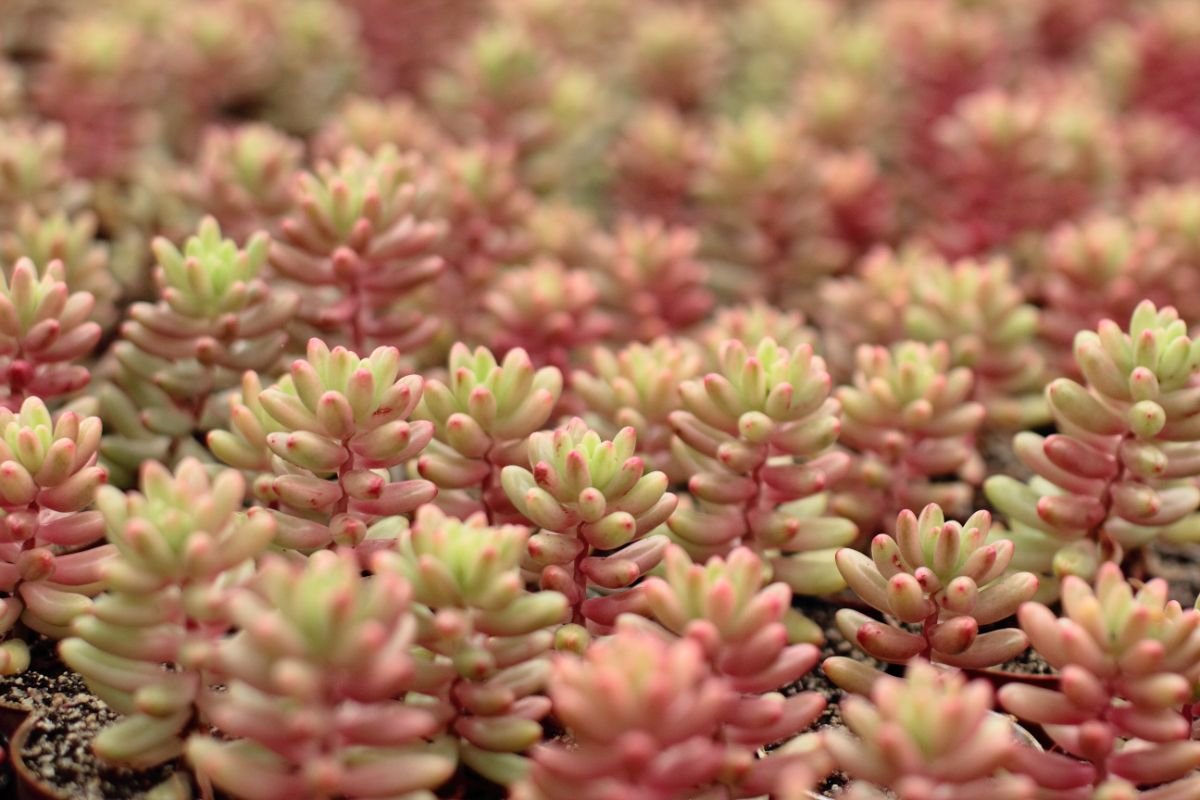
Buy it from:
This plant, also nicknamed Jelly Bean, gets its moniker from the shape of its plump, colorful leaves. Each leaf is about two centimeters long and green with pink tips. The stems can grow about six inches in length, but the plant can spread as far as 36 inches. The plant is native to Mexico and its flowers are small and yellowish white in color.
No products found.
Jelly Beans, like other succulents, thrive with a little neglect. Infrequent watering, plenty of drainage, and partial sunlight will help your plant look its best.
Crassula ovata ‘Pink Beauty’
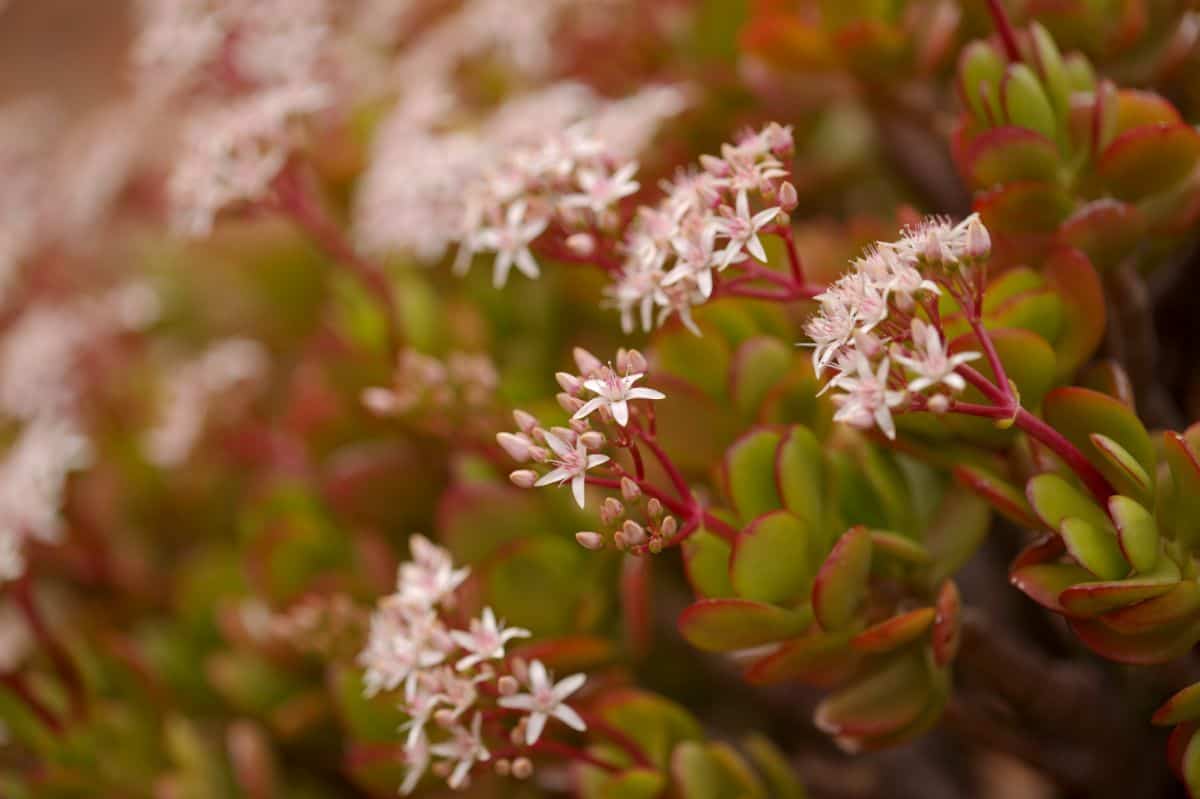
This gorgeous succulent is a variety of jade plant. It possesses the same thick stems and glossy leaves as other, more common varieties of jade. Pink Beauty can grow up to five feet tall and nearly just as wide. The fragrant flowers of this succulent are star-shaped, pink, and incredibly profuse.
The Pink Beauty grows best in full sun but can survive on partial sun if that is all that is available. It thrives on infrequent watering, especially in the winter. It can be propagated from either leaves or stem cuttings.
Crassula pellucida ‘Variegata’ or ‘Calico Kitten’
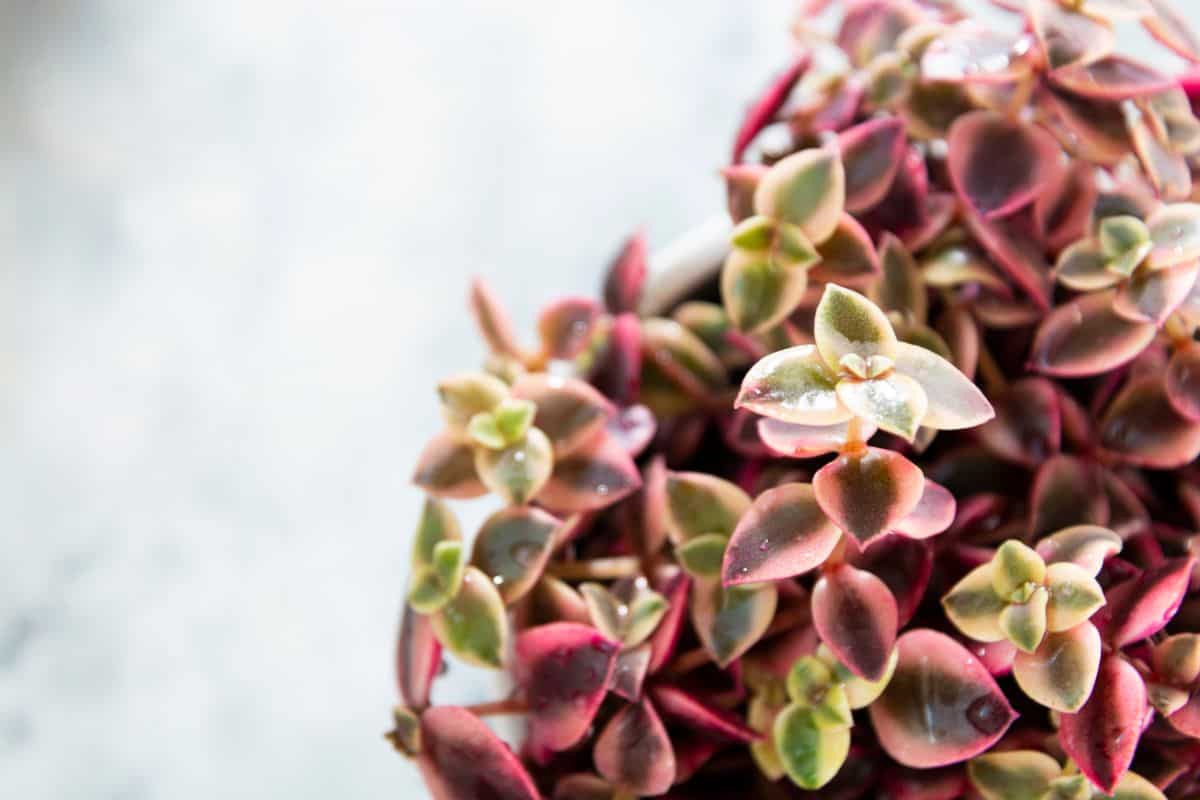
Buy it from:
This adorable trailing succulent is native to South Africa and is known for its variegated, heart-shaped leaves. Stems can reach lengths of up to 12 inches. This plant makes an ideal addition to any garden in a hanging planter or as ground cover. The delicate leaves are green and white with pink leaf margins.
Calico Kitten prefers either partial sun or bright indoor light. They are not frost-tolerant plants and must be protected during cold weather. They are easy to grow and are perfect for gardeners with any level of experience.
Echeveria ‘Perle Von Nurnberg’
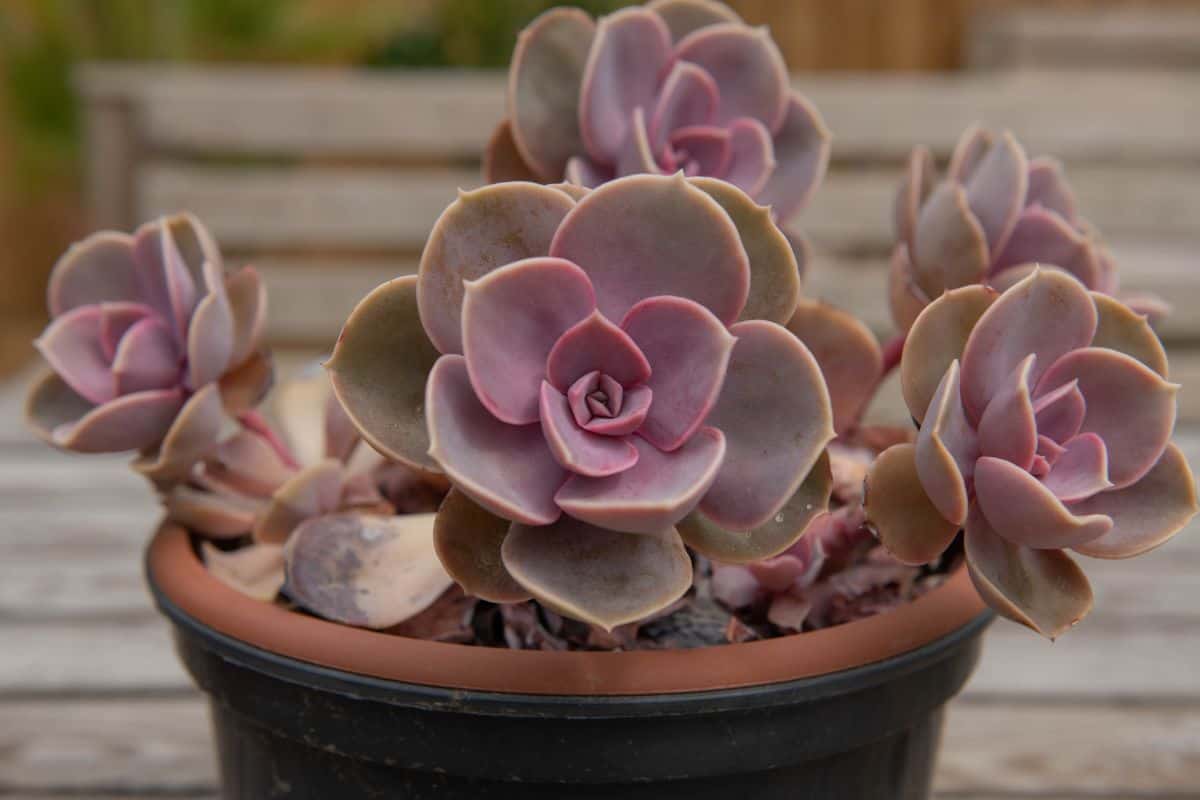
Buy it from:
Perle Von Nurnberg is an interesting succulent with grayish colored leaves with pink highlights. The leaves are covered in powder farina and the rosettes can reach up to six inches in diameter. During the summer, the plant produces pink and yellow flowers on long stemmed stalks.
Like other Echeveria, the Perle Von Nurnberg is easy to grow, even for most beginning gardeners. Infrequent watering will help the plant thrive, as will using the correct type of soil. The plant can be propagated from leaf and stem cuttings, but can also be grown from seed.
Aloe ‘Pink Blush’
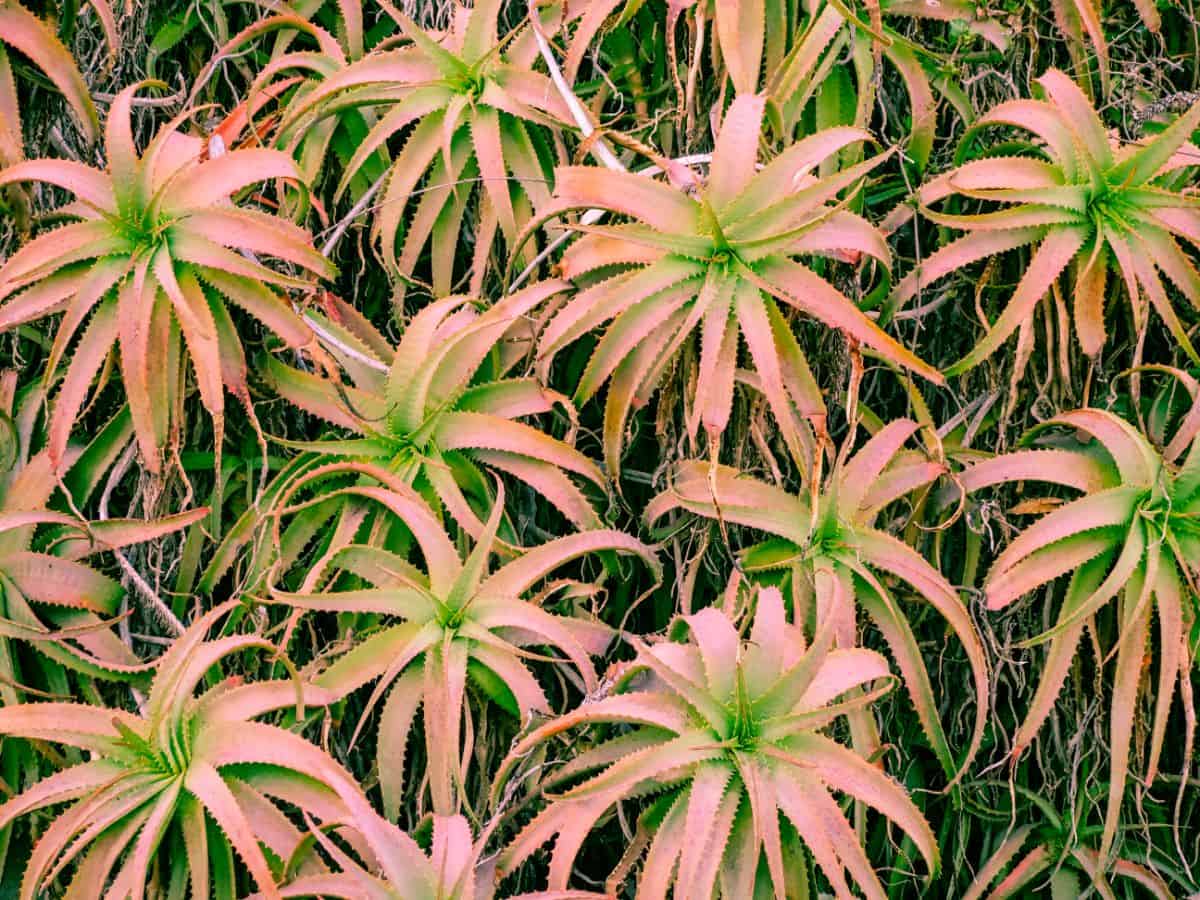
Buy it from:
Pink Blush is a small hybrid Aloe, growing only up to about one foot tall and five inches wide. The leaves are varying shades of green with pink ridges. In late winter or spring, this adorable succulent produces short stalks with orange flowers.
Pink Blush is as easy to care for as many Aloe plants. It prefers relatively infrequent watering, with almost no water during the winter months. It enjoys well-draining soil and will not survive if overwatered.
Graptopetalum paraguayense ‘Ghost Plant’
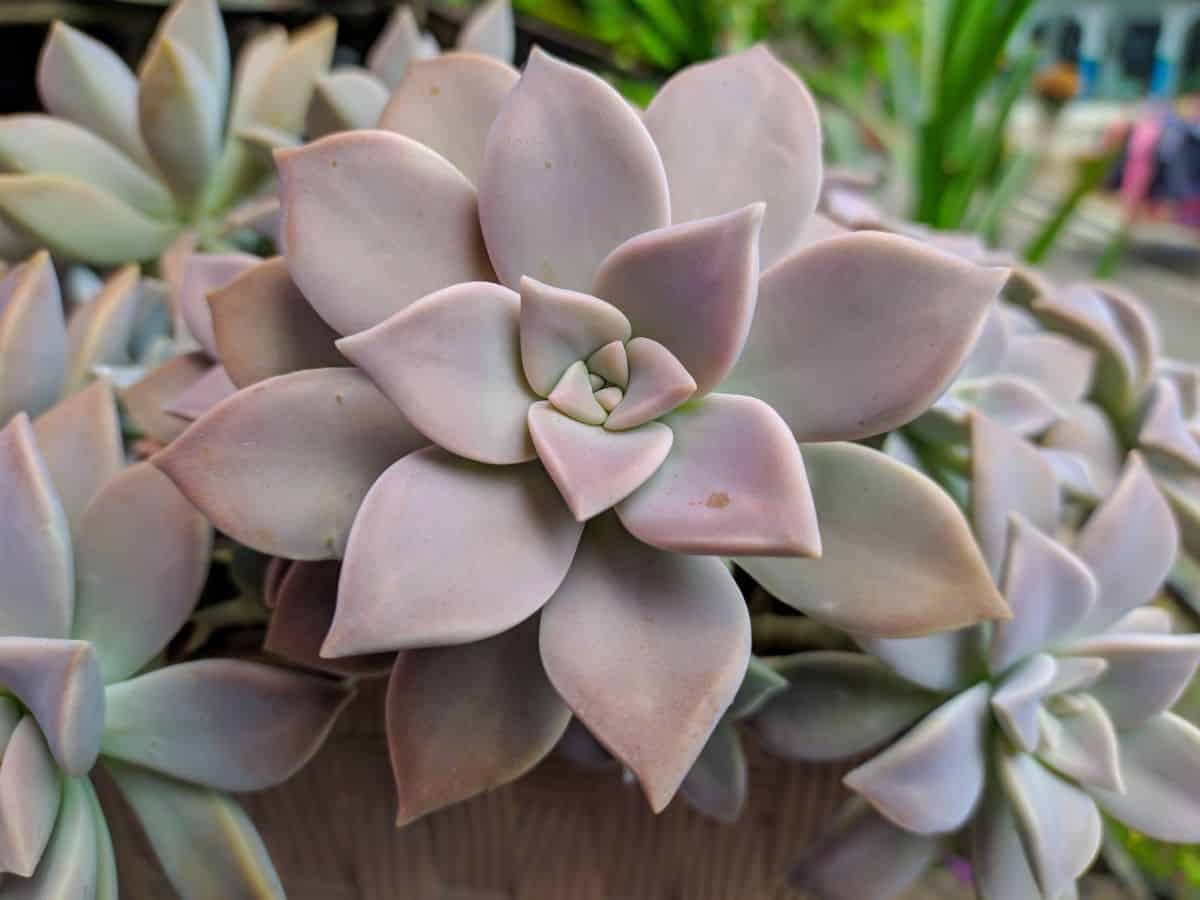
Buy it from:
The Ghost Plant is native to Mexico, and you should be aware that there are many species that go by the name "Ghost Plant". This beautiful succulent has thick triangular leaves in a rosette pattern that can measure up to six inches in diameter. The color is typically a pale blue or purple with hints of pink. The more sunlight the plant receives, the pinker it will be.
The Ghost Plant thrives in full sunlight with infrequent watering. Many gardeners choose to trim their plant to keep a fuller, rounder shape, rather than let it spread naturally. It is incredibly easy to propagate from either single leaves or stem cuttings.
Graptoveria ‘Douglas Huth’
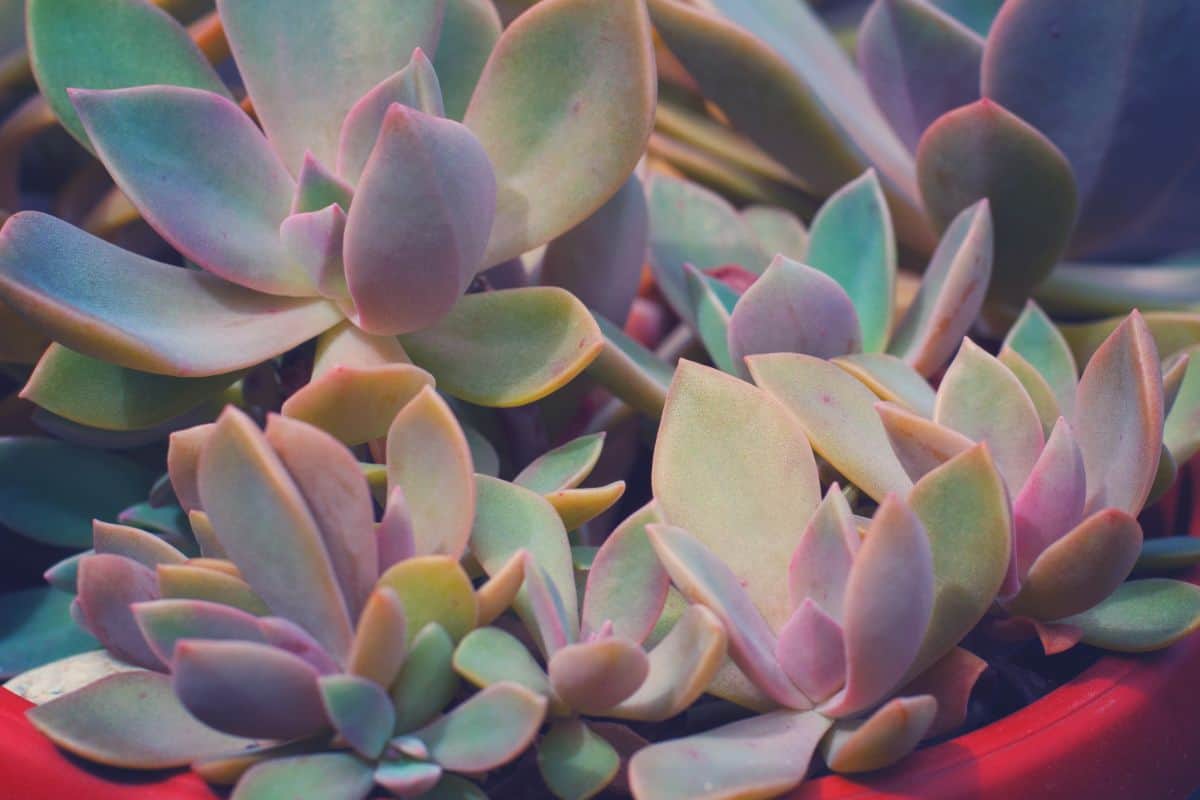
Buy it from:
The Douglas Huth is a hybrid succulent, created from combining Echeveria and Graptopetalum plants. The leaves are thick and grayish-green in color with a slight pink hue. When the plant blooms, it produces petite pink flowers. The rosettes can grow up to eight inches in diameter and the stems can reach up to eight inches in length.
The Douglas Huth is not a frost resistant plant and prefers warm, dry climates. It is relatively easy to grow, even for inexperienced gardeners. It prefers full sun and is easy to propagate. It’s also a great addition to pet-friendly gardens. They're somewhat rare, but you can usually find one or two sellers on Etsy.
Echeveria ‘Rainbow’
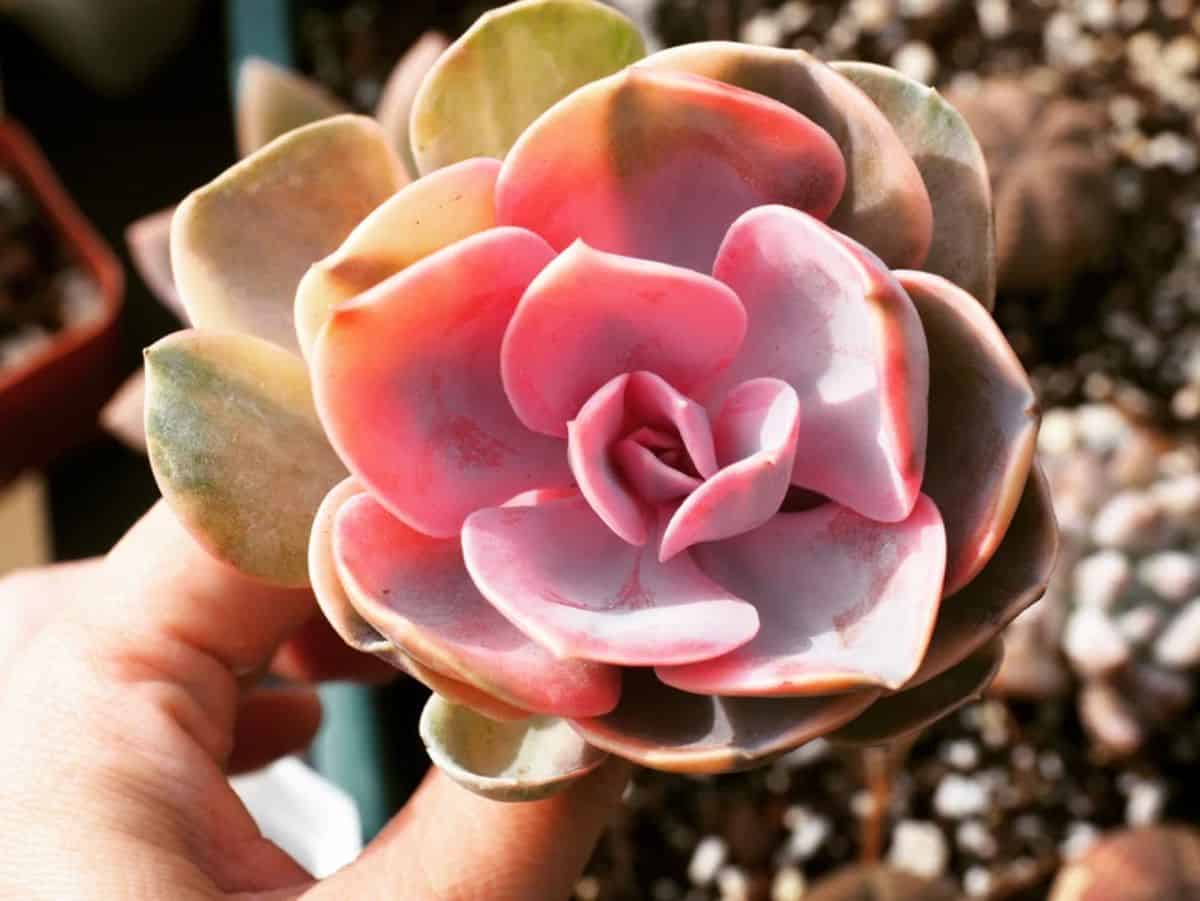
Buy it from:
The Rainbow is actually a variegated form of Perle Von Nurnberg. Instead of the solid colored leaves of the Perle, the Rainbow has green and yellow striped leaves with pink highlights. There is also a slight ruffle along the leaf edges. The rosettes can measure up to six inches in diameter.
As with other Echeveria, the Rainbow is incredibly easy to care for, especially if you tend to neglect your plants a bit. They prefer well-draining soil and proper watering techniques. They do well in full sun, but must be protected from frost.
Anacampseros telephiastrum – Variegata or Sunrise
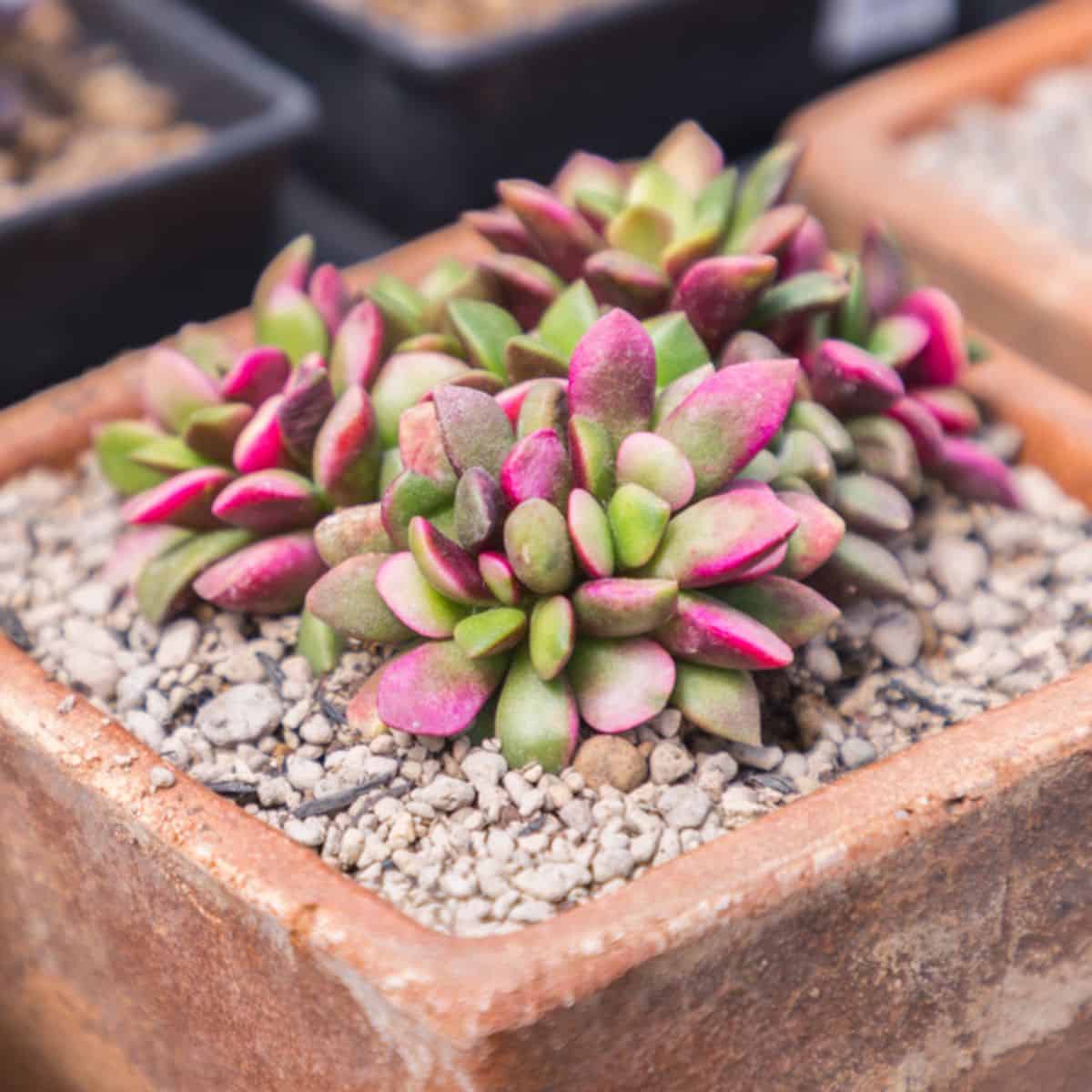
Buy it from:
This little succulent is at the top of our list for a good reason. It is one of the few true pink succulents that exist. The leaves remain a light pink to a darker almost burgundy pink while newer leaves are a light green. The leaves are thick and triangular from a profile; with tightly packed rosettes the leaves hide the entire stem.
As this species grows, the rosettes can start to extend out of the pot, form a mat, and they can also start to creep. Pink Blush will easily offset, and it also propagates well. With rosy leaves, it's probably one of the first pink succulents that you want to add to your garden
Echeveria sp. - Can-Can
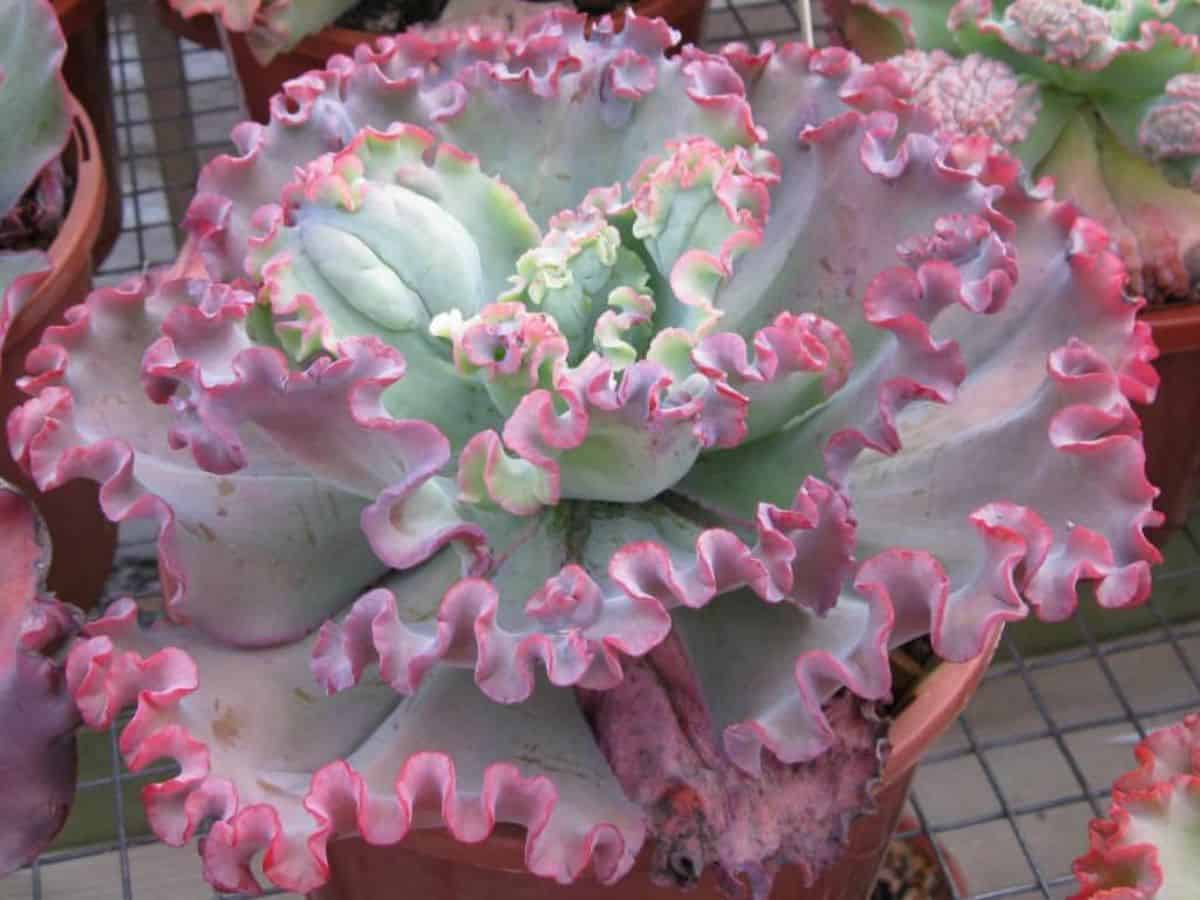
Buy it from:
The Can-Can, so named because of its ruffled leaves that resemble dresses worn by dancers, is a succulent that can get up to 14 inches in diameter. The primary color of the leaves is a light blue-green, but the edges are truly what makes this succulent stand out. Every single wavy leaf is edged with a dark red to a light pink. The vast majority of the leaves take on more of a purple tone while the very edges of the margins will seem slightly more reddish. The Can-Can grows reddish pink flowers that generally appear in summer.
Graptopetalum rusbyi
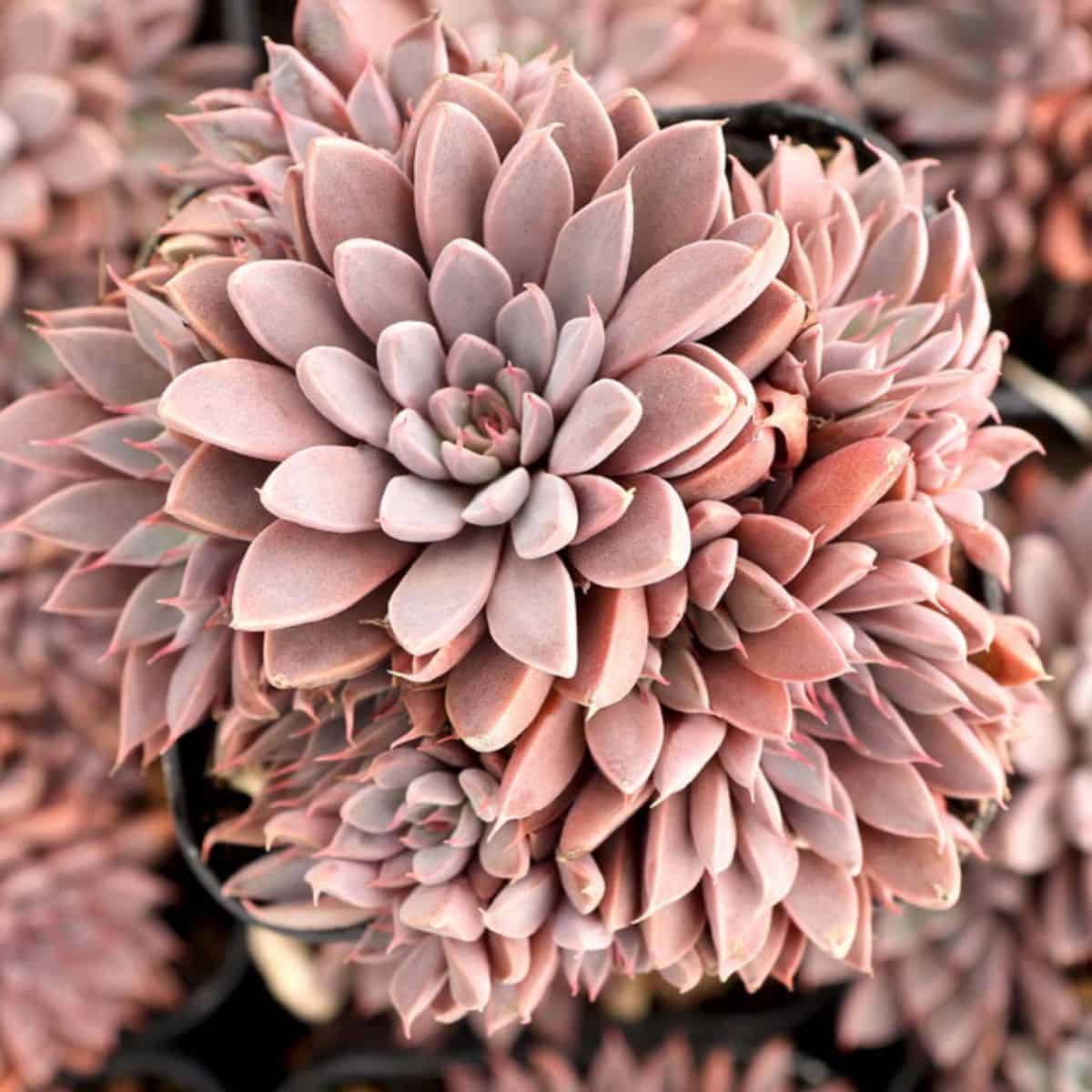
Buy it from:
This is a succulent that doesn't just add color to your garden. The rusbyi adds additional texture to your garden not just because of its perfectly shaped leaves, but also because of the scales that form along the leaves themselves. These scales make the leaves look more tongue-like especially considering their shape is also like tongue except for the tip which comes out to a fine point. The rusbyi produces many offsets and can easily grow into a very large clump. They do maintain their dusty pink color throughout the year: during their offseason and under stressful situations this pink may darken. In large clumps, it is difficult to see where one rosette begins and where another ends. This makes them a fantastic clumping succulent.
Graptosedum sp. - ‘Alpenglow’
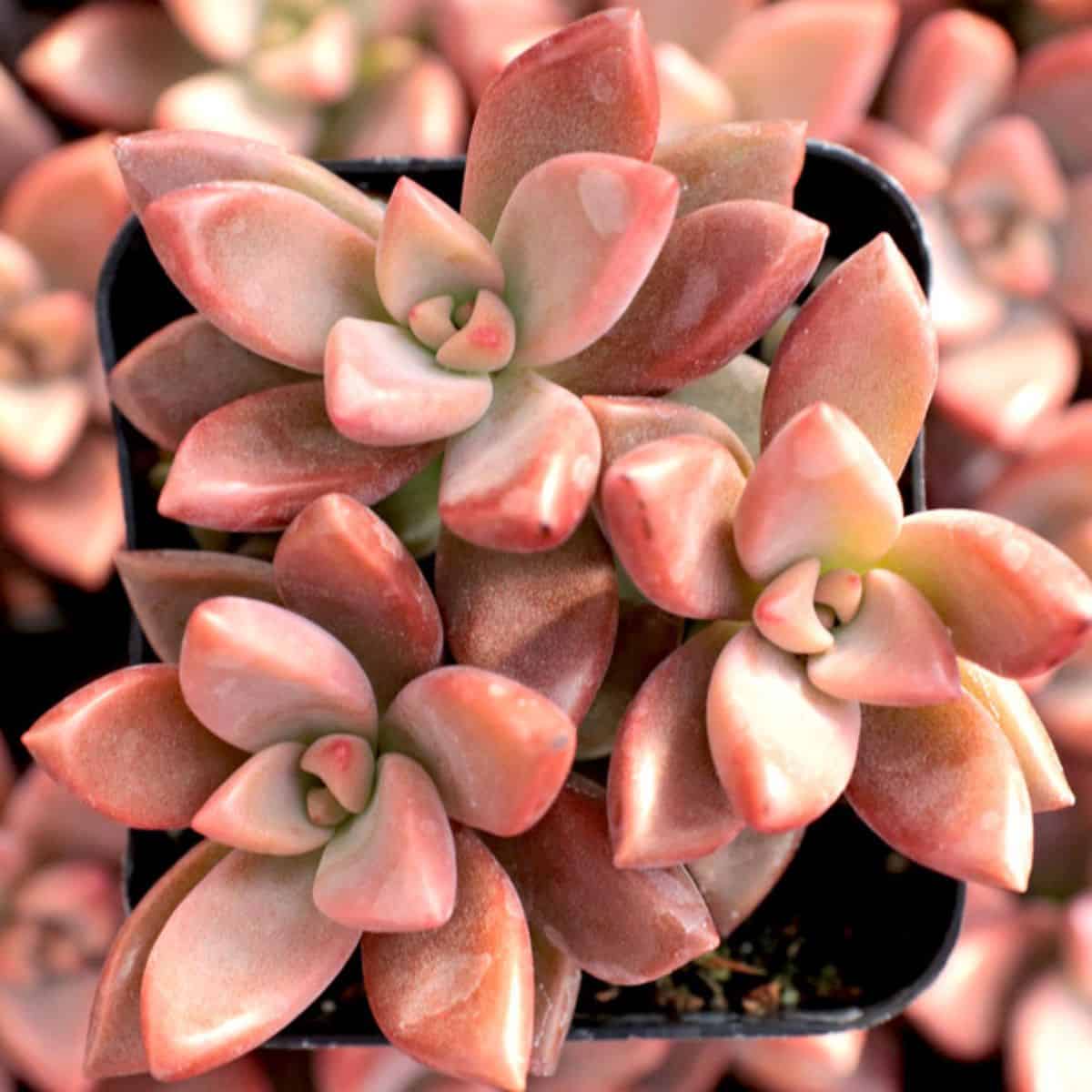
Buy it from:
The Alpenglow is another beautiful graptosedum that is fully pink throughout the year. For this succulent, the center of the rosette takes on a more orangey color, and older leaves will also take on an orange color. The leaves form delicate triangles, and the rosettes are very tightly packed. The plant itself can get up to 8 inches tall and 12 inches wide. Spring is their blooming season when they begin to produce yellow flowers in the spring. If you're looking for that pink twist to your garden, then the Alpenglow is a great choice.
Aeonium sp. - Pink Daisy
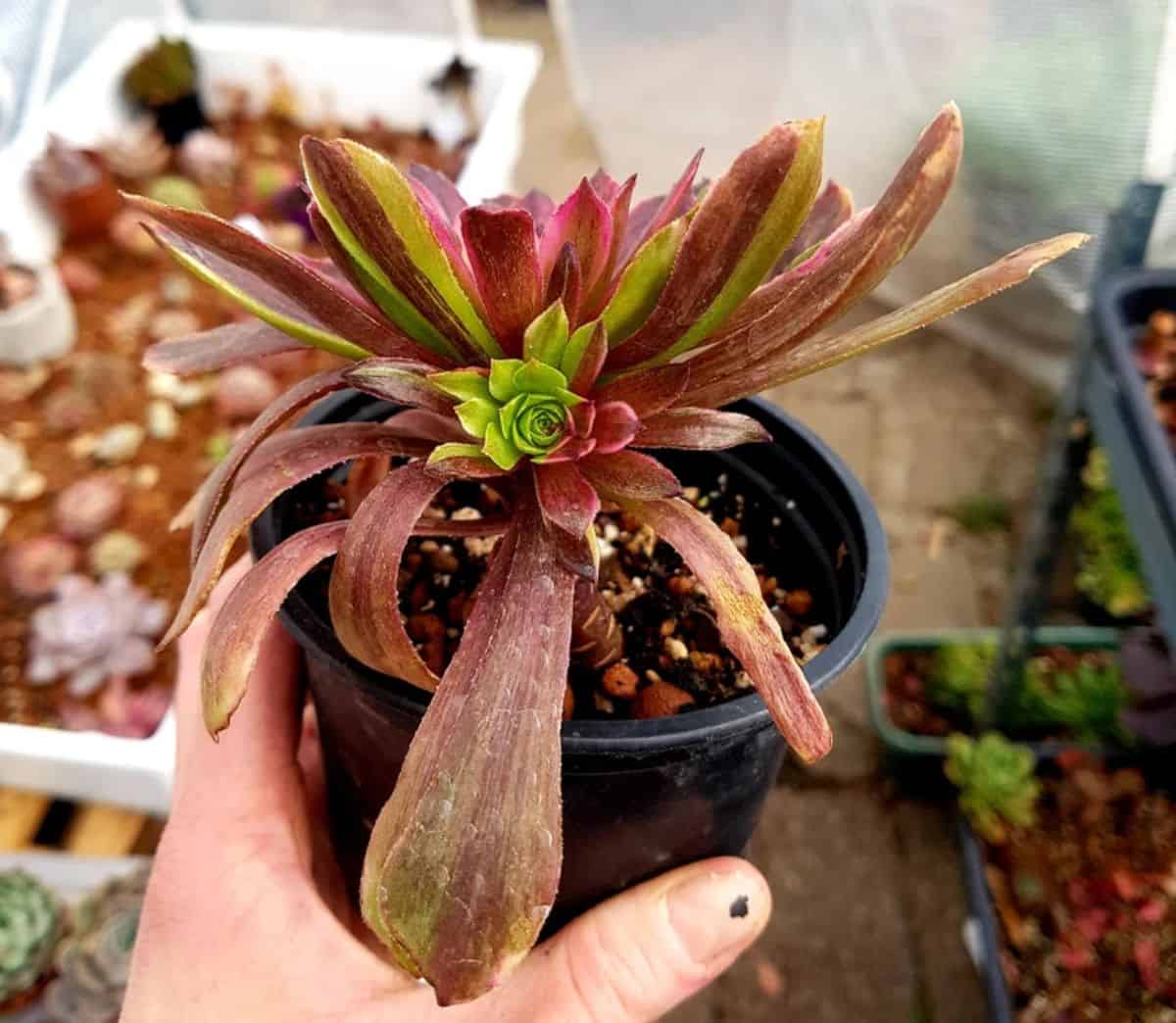
Buy it from:
The Pink Daisy is much like other aeoniums. It is a variation of the aeonium Mardi Gras and it features very bright hot pink margins. The center of the leaves tend to be more of a burgundy brown which then fades to a light green then hot pink. The rosettes are tightly packed and the leaves are oblique. Aeoniums branch into several rosettes that makes them look like mini trees.
Aeonium sp. - 'Pink Witch'
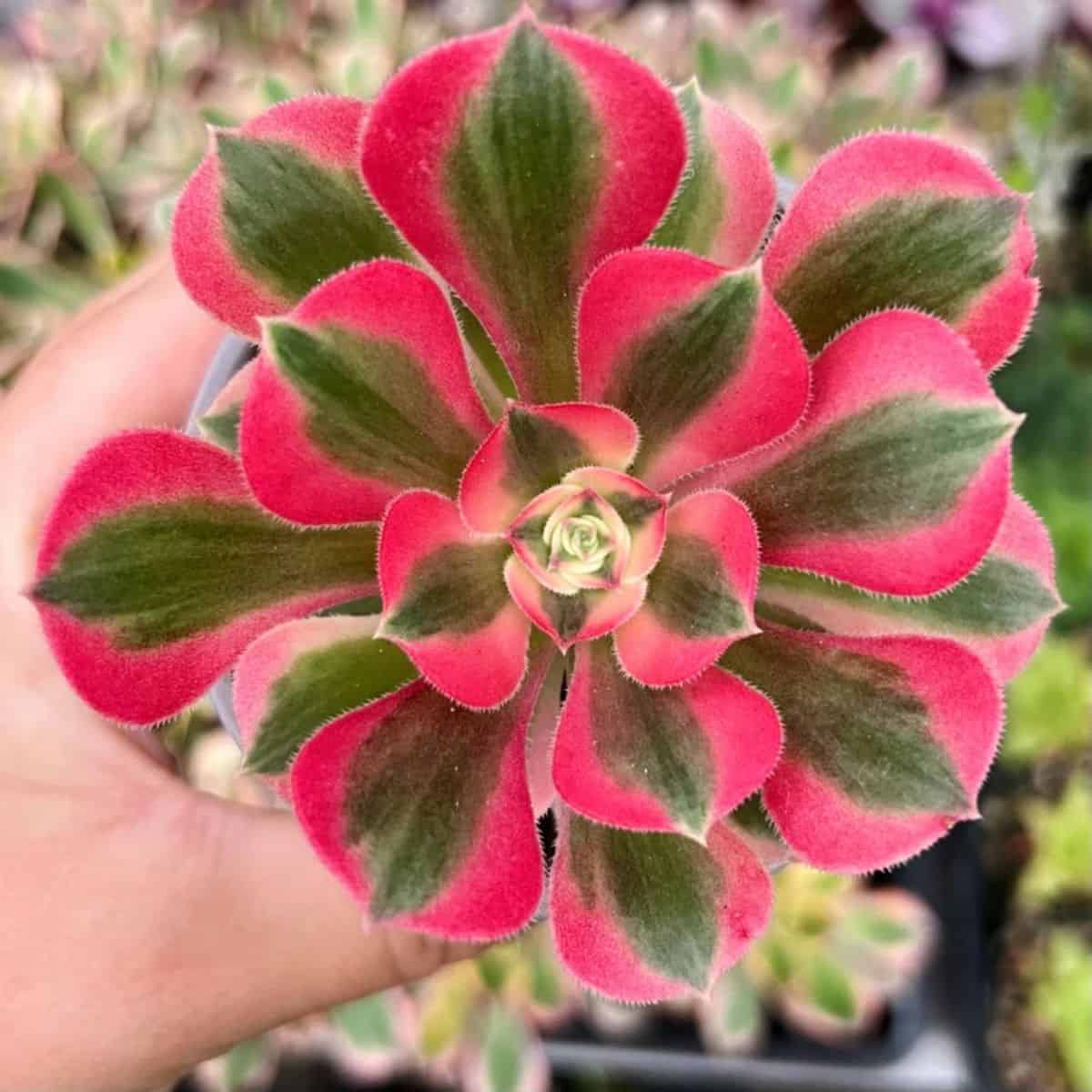
Buy it from:
A step up from the Pink Daisy, is the Pink Witch. While the Pink Daisy has small margins of pink, the Pink Witch has very large margins that go from a hot pink, to a very light yellow. The center of each leaf is a peridot green that fades to burgundy at the tip. This species will change color to a more yellow hue when stressed or out of season. Pink Witch branches like other aeoniums and will also form small trees. It can take several years for an aeonium to form several rosettes.
Echeveria sp. - Pink Champagne
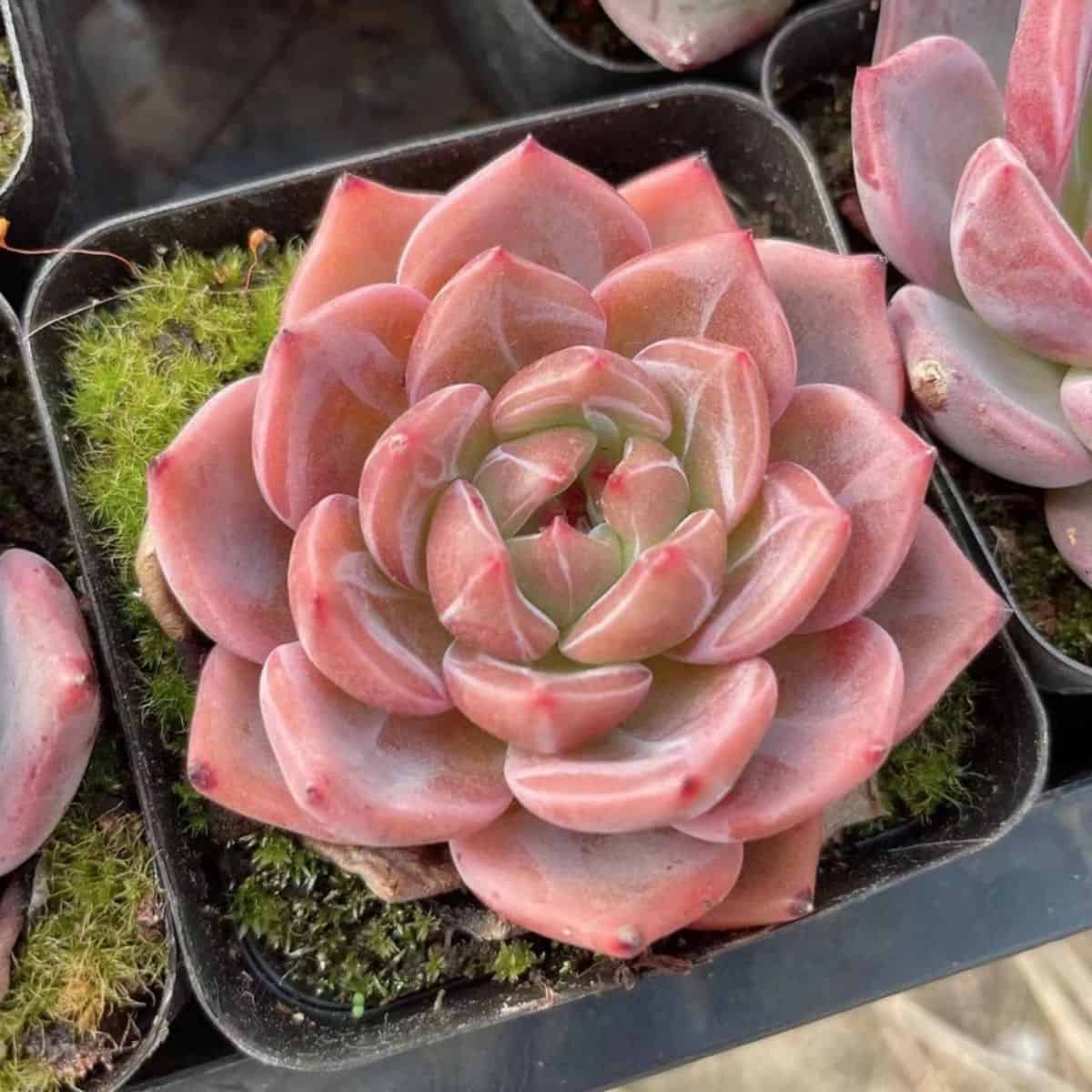
Buy it from:
One of the most common pink colors for succulents, is a dusty rose. Pink Champagne has bright orange flowers that grow on a very tall stem stalk. The leaves can get up to five inches long and they maintain their pinkish color nearly year round. At the center of the rosette, young leaves are light green to a light green-blue. The leaves themselves are plump and come to a very delicate point. Keep in mind, that there may be farina that develops on the succulent which can give it a light dusty rose appearance.
Kalanchoe sp. - Pink Mother of Thousands or Pink Butterflies
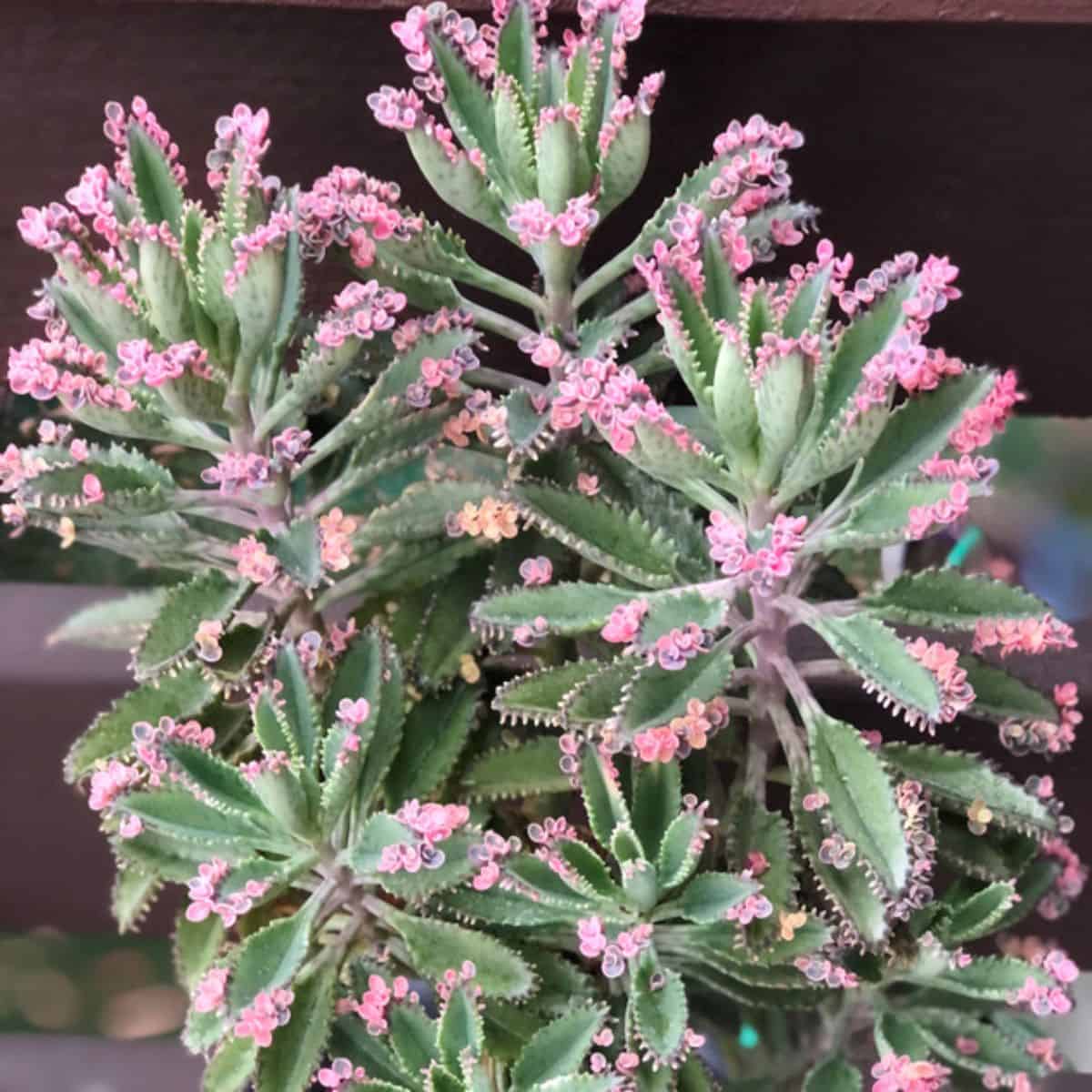
Buy it from:
Mother of Thousands is a succulent that is on my list. The species itself is very interesting as it self propagates along its leaf margins. The individual “children” can vary greatly in their flowering color. Pink Butterflies, as the name suggests, has bright, light pink offspring. Mother of Thousands is known to be a slightly finicky succulent, but regular care can ensure a long life. Keep in mind, that if any of the new flowers separate from the mother, land on the ground, and take root, well, you'll soon have a forest of Mother of Thousands
Anacampseros telephiastrum - Sunrise
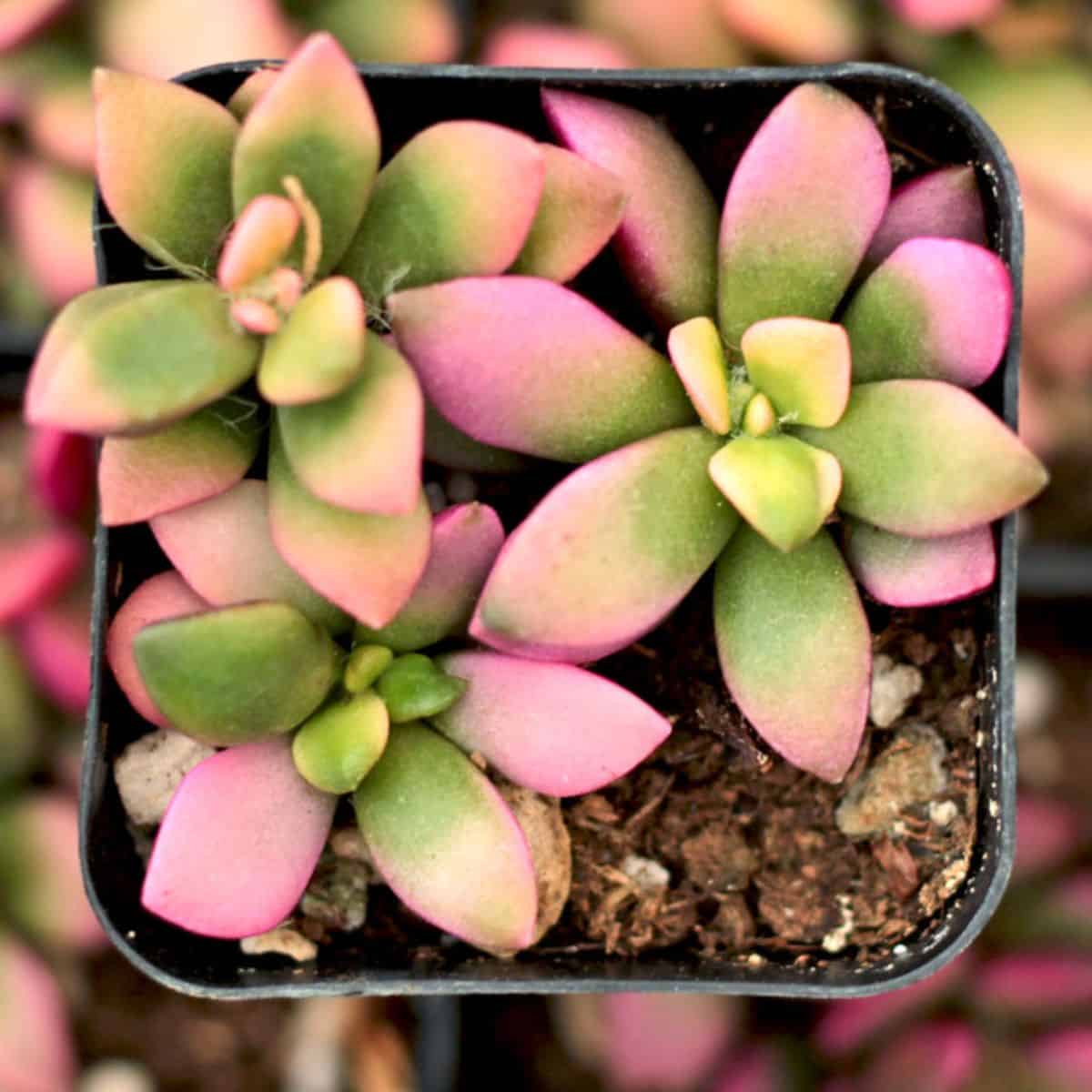
Buy it from:
Boasting the delicate colors of a soft morning sunrise, this species is primarily pink. The leaves begin as medium green with slight pink margins, and they then develop into mature, more solidly pink leaves. The older the leaf becomes the lighter the pink color. This species does offset very easily and can get up to six inches in diameter. This is a species of succulent that needs to be protected from direct sunlight: the Sunrise can easily be sunburned due to its delicate leaves. This is a summer active species that produces soft pink blooms.
Callisia repens – Pink Lady Turtle Vine
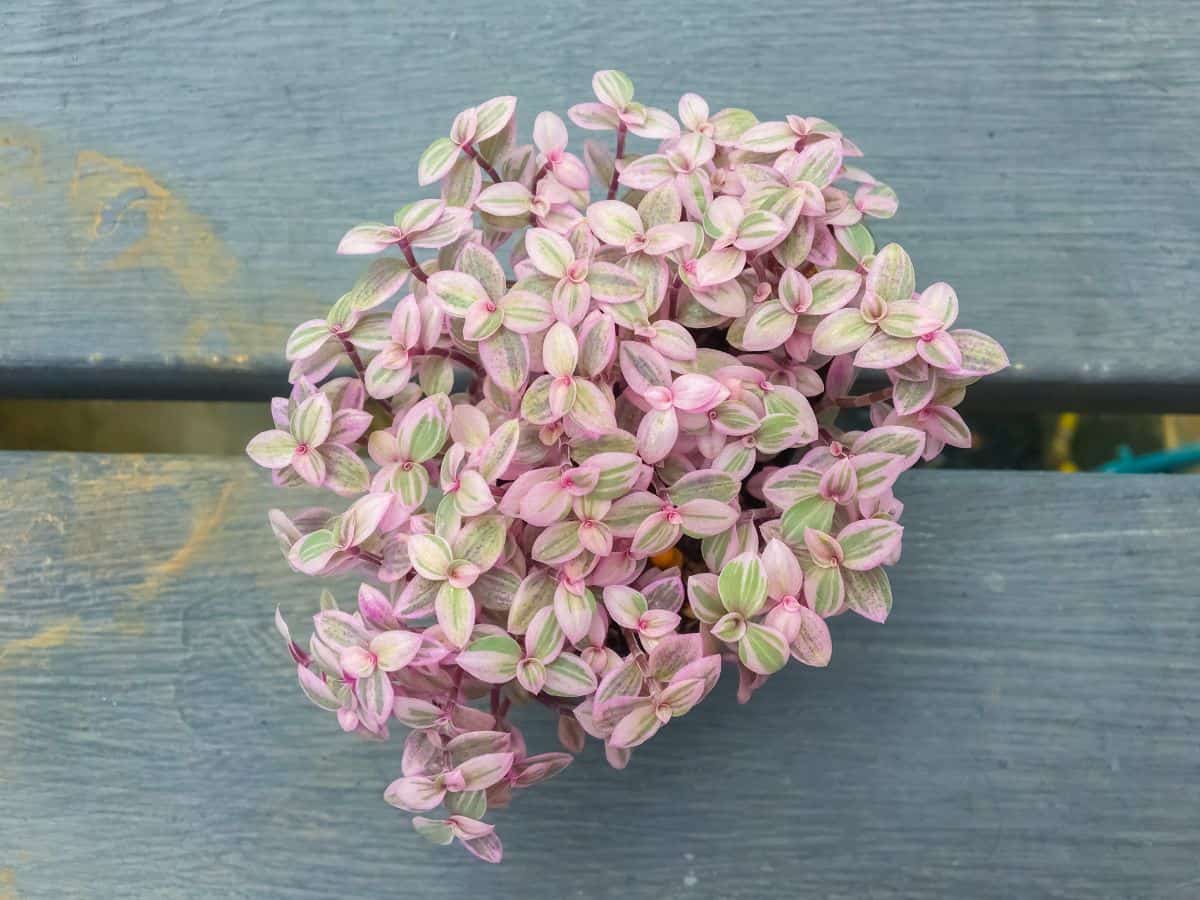
Buy it from:
The Pink Lady is a delicate looking fine. It is considered to be a turtle vine due to the shape of the leaves that resemble the back of a sea turtle. The Pink Lady species is a light green, with white medians and light pink variegation. Where this succulent shines is it’s deep burgundy under leaf that is a striking contrast to the top. Because this species is so delicate, ensure that when it is in full sun it is not in a direct ray.
Sempervivum sp. - ‘Dame Arsac’
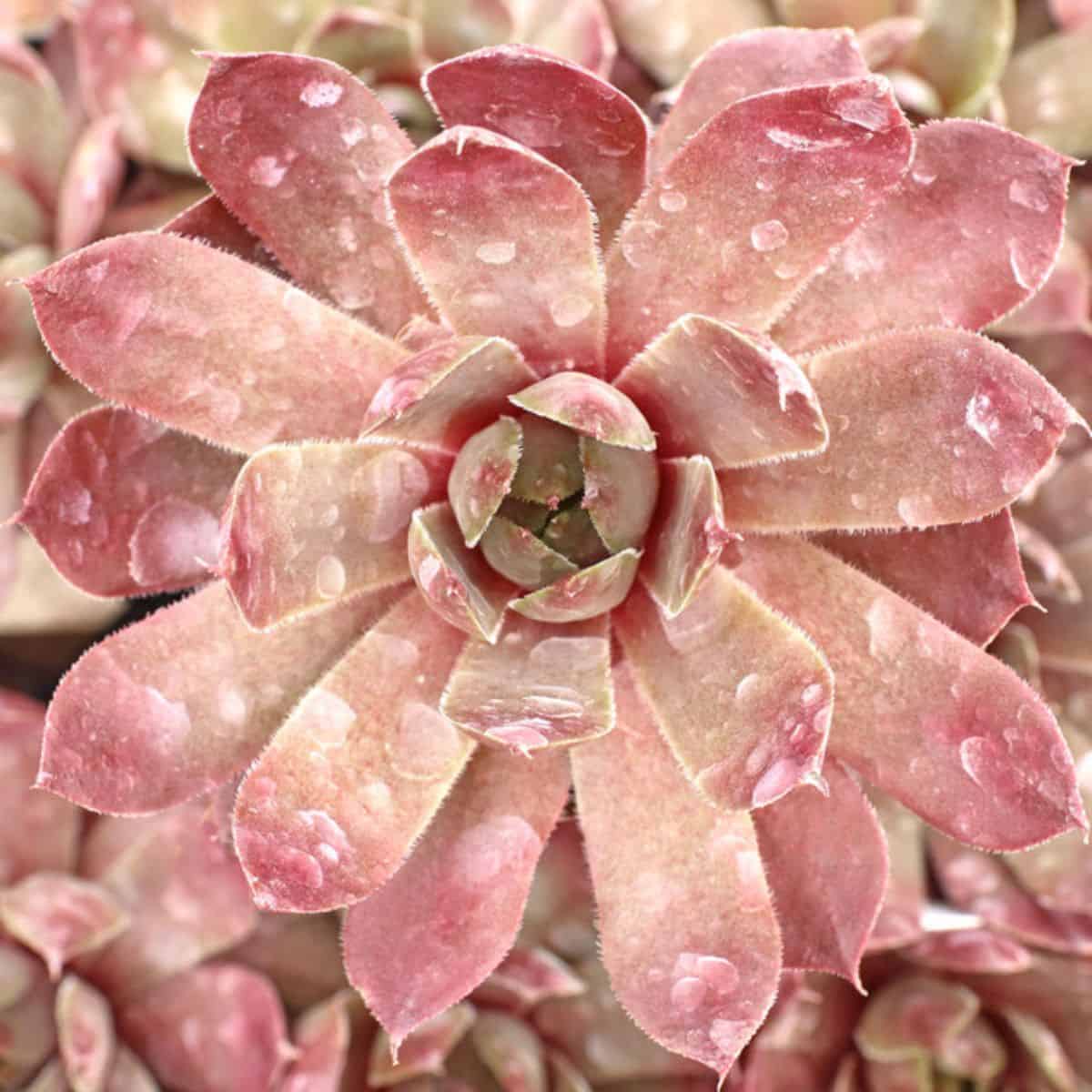
Buy it from:
This species is well known for maintaining bright flushes of pink and orange. When not under stress situations, I.e. growing indoors, this succulent will maintain a very slight pink flush to the center of most of its leaves. With a tight rosette, spiny margins, and full spoon shaped leaves, the Dame is truly an elegant addition to any garden. This is a rare version of sempervivum which makes it highly desirable and it is often sold out. This species can get up to six inches in diameter, they prefer filtered sun, and will start producing a vast amount of chicks during the summer. During the summer, this species also produces bright pink blooms.
Sempervivum sp. - Woolcot
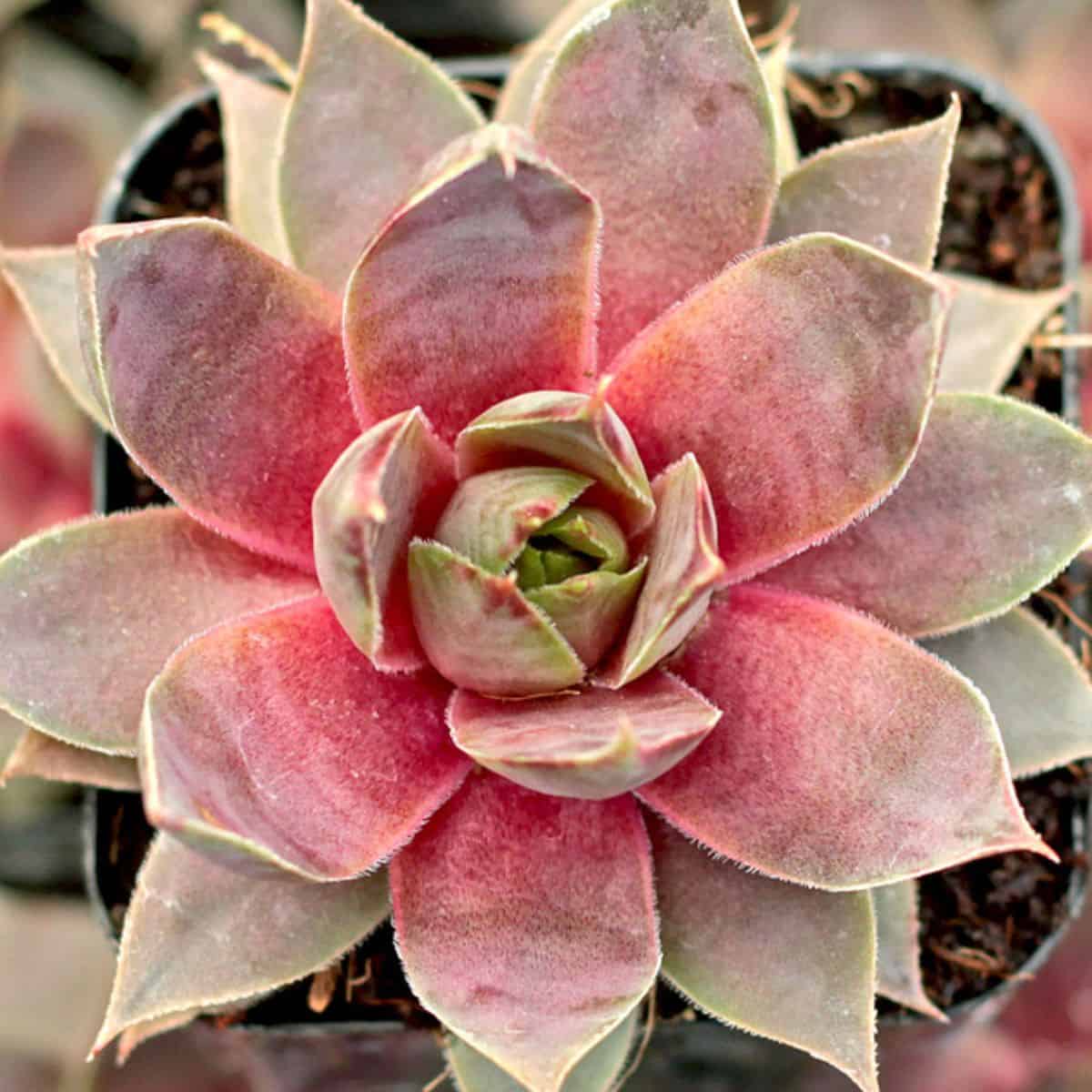
Buy it from:
A Woolcott is a fun color changing sempervivum that can get up to six inches in diameter. Instead of maintaining a green color at any point of the year, this species changes color throughout the year. From blushing pinks, to dusty roses, to the slight pinkish purple of fall and the deep purple of winter, there's always some pink to be seen on this sempervivum. During wintertime, the margins and spiny tips will begin to turn pink. As soon as she begins to come into the spring and summer months be sure to watch out for the flowering stalks. The Woolcott will grow into a large clump if left to grow in the ground or in a pot that is large enough. They also prefer partial sun.
Echeveria sp. - The Rose
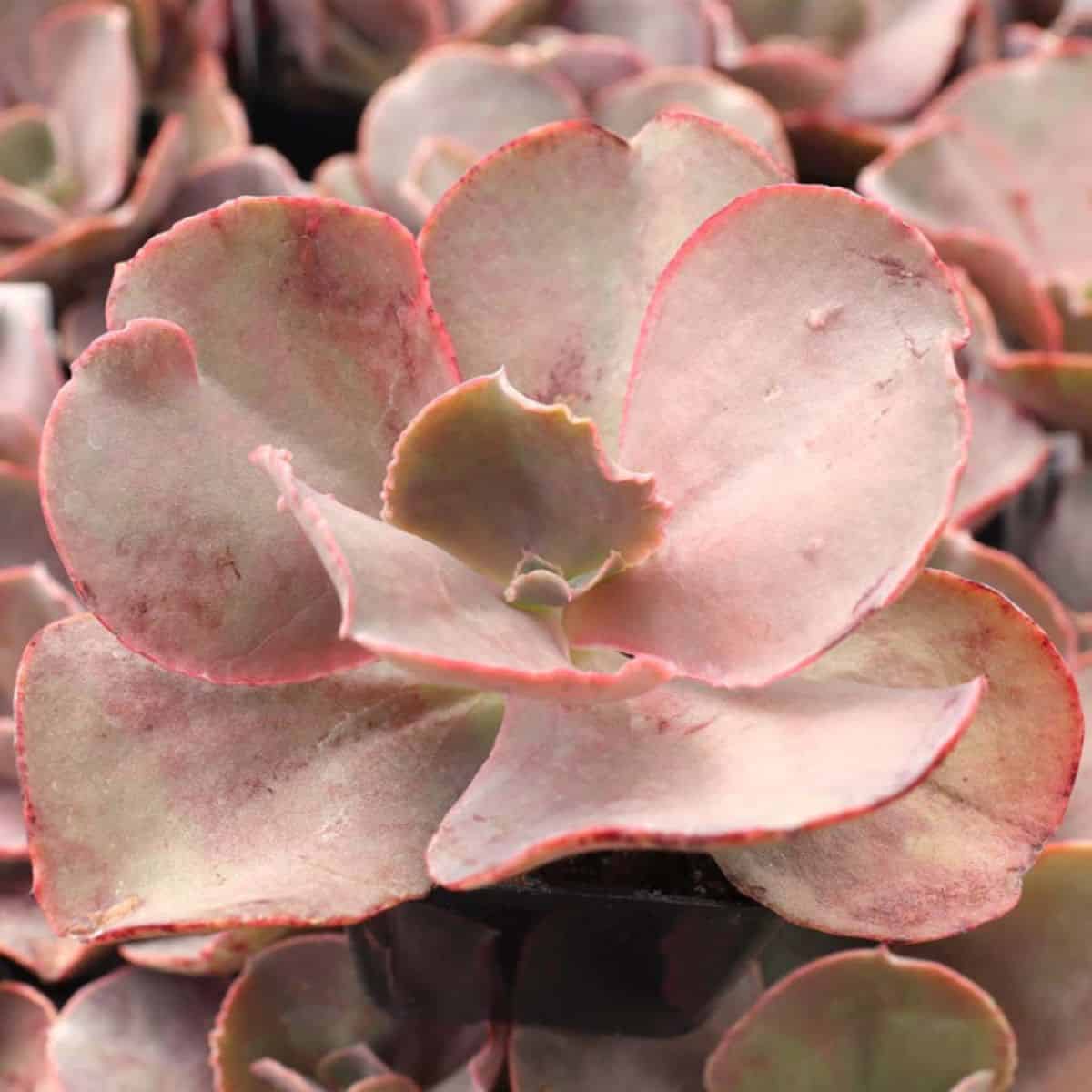
Buy it from:
Yet again, we encounter an echeveria that is a light dusty rose. Unlike other variatns with the dusty rose coloration, The Rose has very unique leaf structure as well as a deeper rose color. The leaves themselves are undulate, however the amount of wave in the leaves can vary by plant or by leaf. When under any sort of stress, The Rose will begin to turn a darker coppery color or even a dark red. The leaves are very broad and rotate in a pattern similar to that of a fully opened rose. With pink blooms and a hardiness in zone 10 this echeveria is a great addition to your garden.
Sedum sp. – Sunsparkler Wildfire
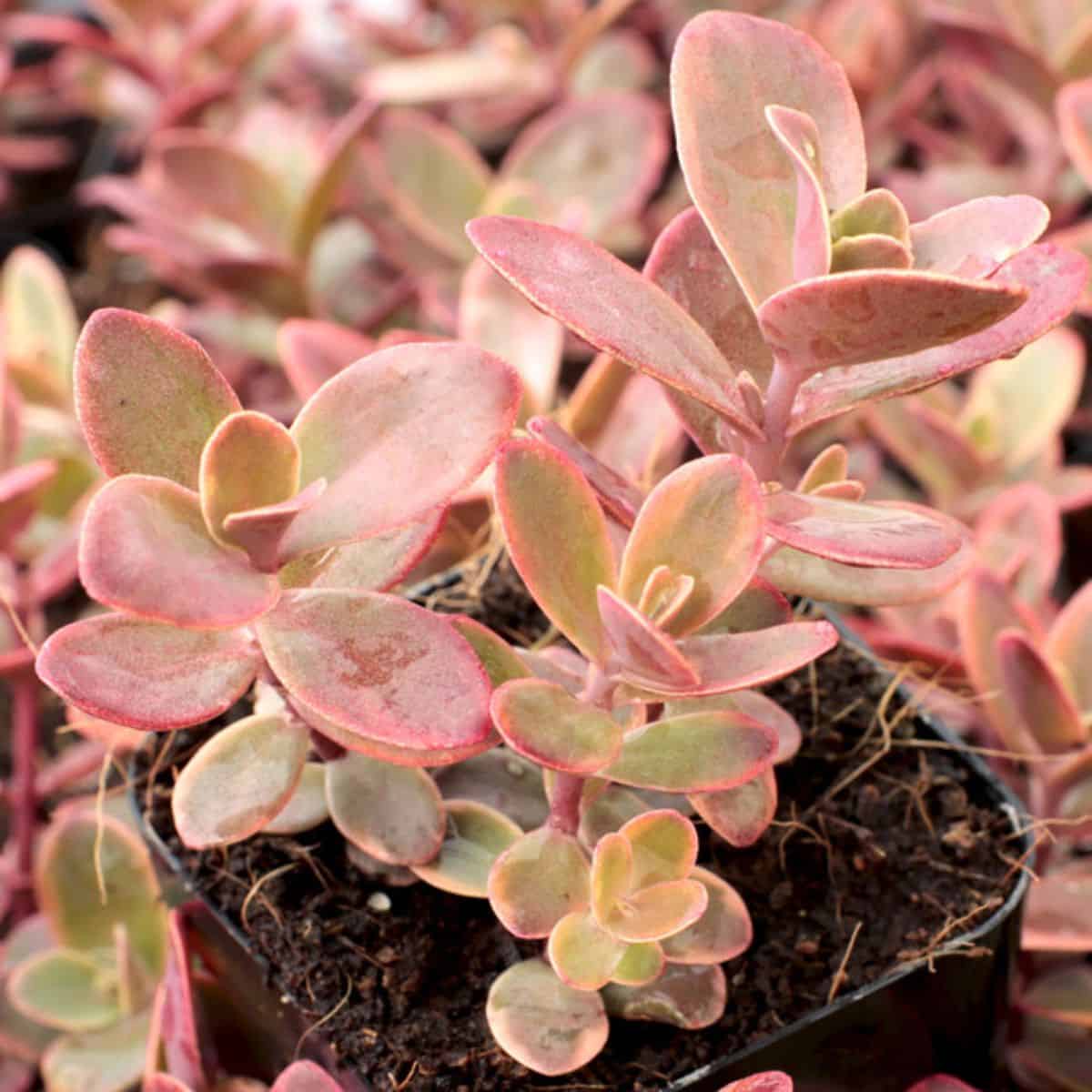
Buy it from:
From the list of designer succulents, here is another Sunsparkler species. Wildfire is known for its light green young leaves, and it's older deep pink leaves. This coloration comes from slight stress. Wildfire gets up to 6 inches tall while, as the title of creeping succulent indicates, it can grow in vast patches. In the summer it does produce pink blooms as the leaves reach a deeper red. When the leaves mature, they take on a variegated green and yellow appearance. This is a cold Hardy species that can go all the way up into zone four and still survive. Like most sedum, the species is no different in that it requires full sun.
Graptoveria sp. - Bashful
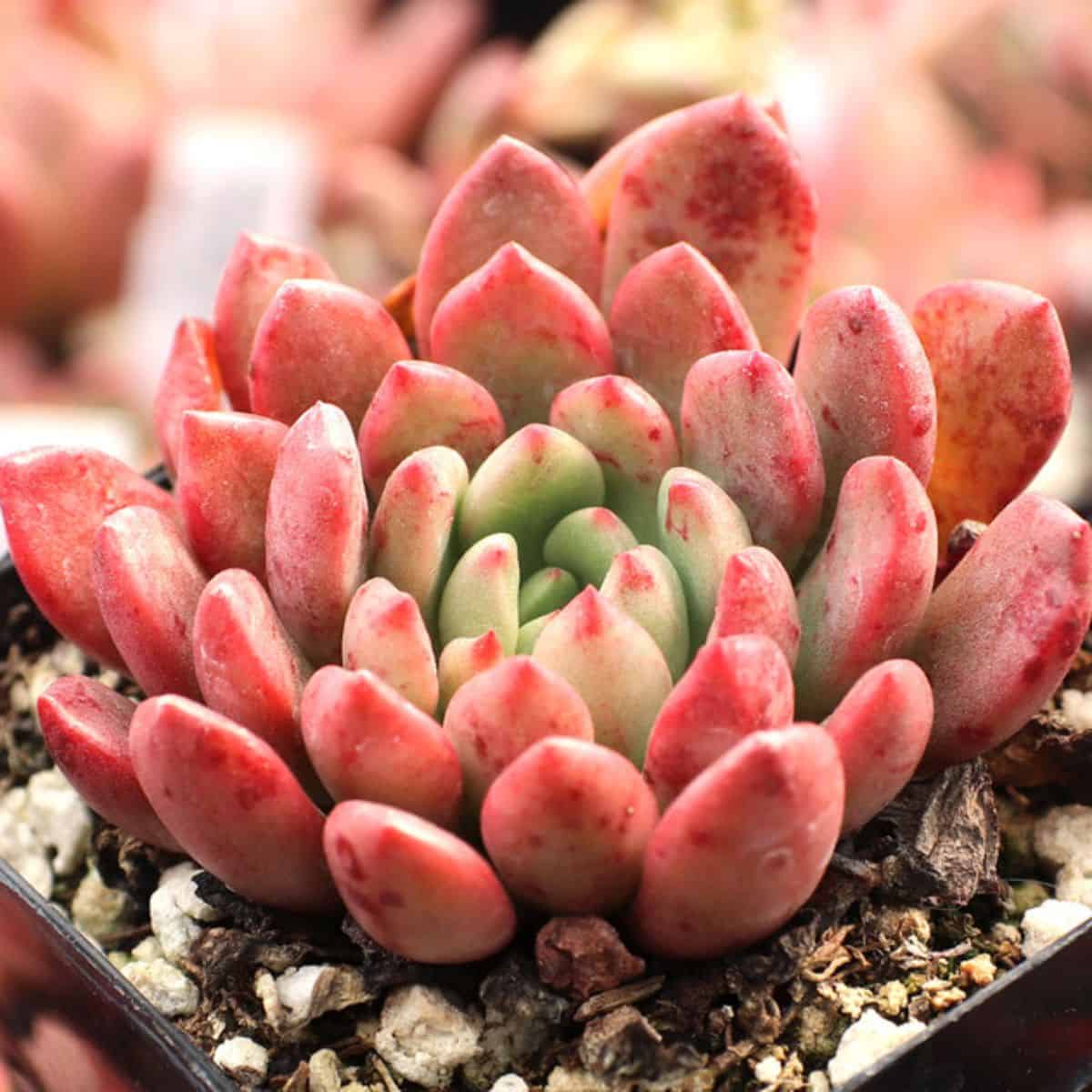
Buy it from:
Bashful lives up to its name considering that the center is a very light and pale green, and the outer edges of all of the leaves are an intense pinkish red. It's almost as though the succulent is blushing! The leaves are full and round with a slight margin along the back of each leaf. The young green leaves maintain a pink spike at the top of each leaf. This species does begin to grow slightly more purple when under a stressed situation. They have white blooms in the spring and enjoy bright indoor light or partial sun.
Sempervivum sp. - Jungle Shadows
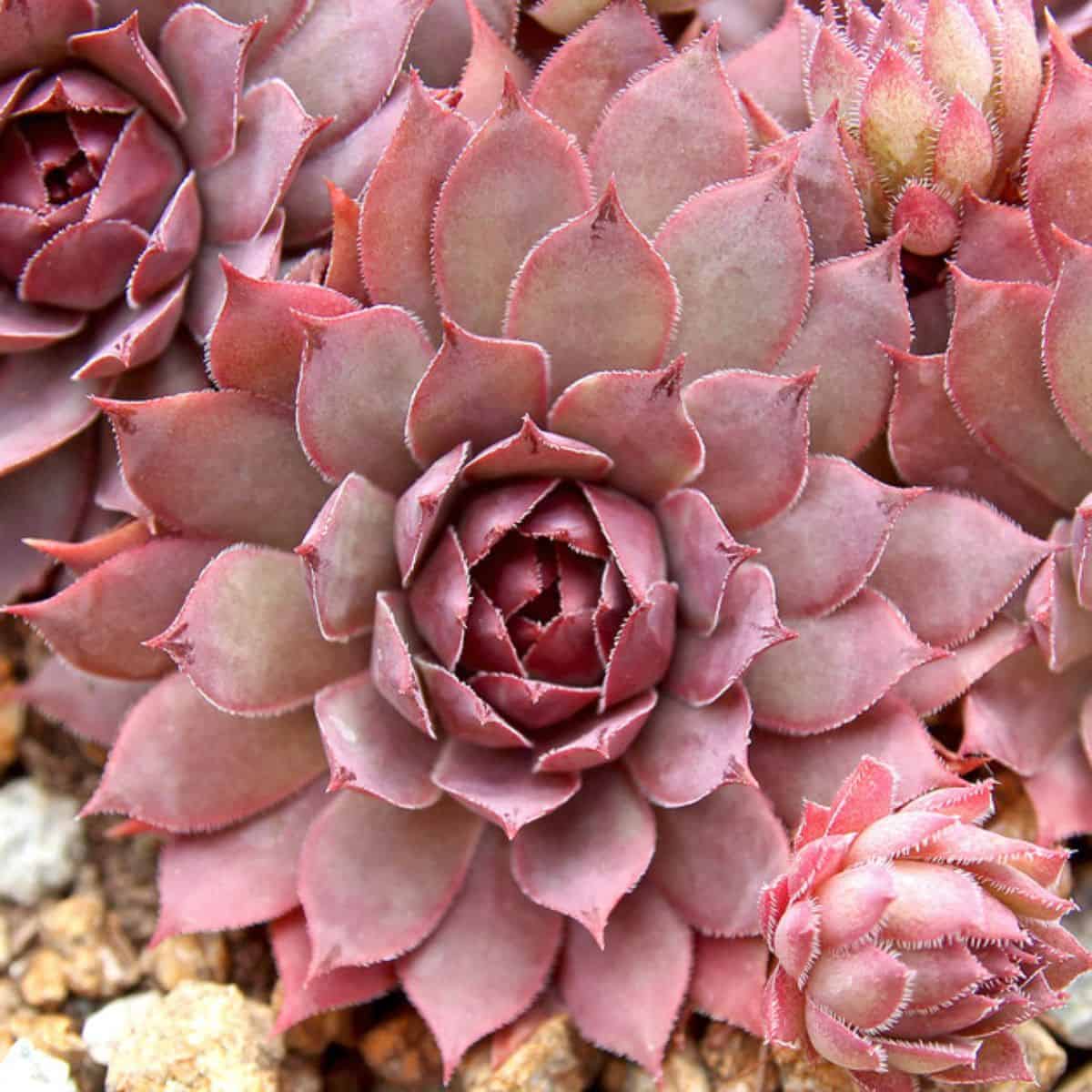
Buy it from:
With such a mysterious name it is fitting that this succulent seems to take on a ghostly pink appearance. Down towards the base of the leaves, Jungle Shadows tends to be a lighter pink. Further up the leaf especially on younger leaves, a white farina band forms which then transitions into a darker pink at the tip. The leaves are full and slightly curved, and they form a well-organized rosette. This is another color changing species that maintains a light dusty rose when not under stress. Jungle Shadows will begin to turn pink when under slight stress, and during winter months it will begin to look like a deep purple along the edges with bright pink at the center. Keep watch for pink blooms and ensure that this plant has enough sunlight to help it keep its color.
Sempervivum sp. – Rose Queen
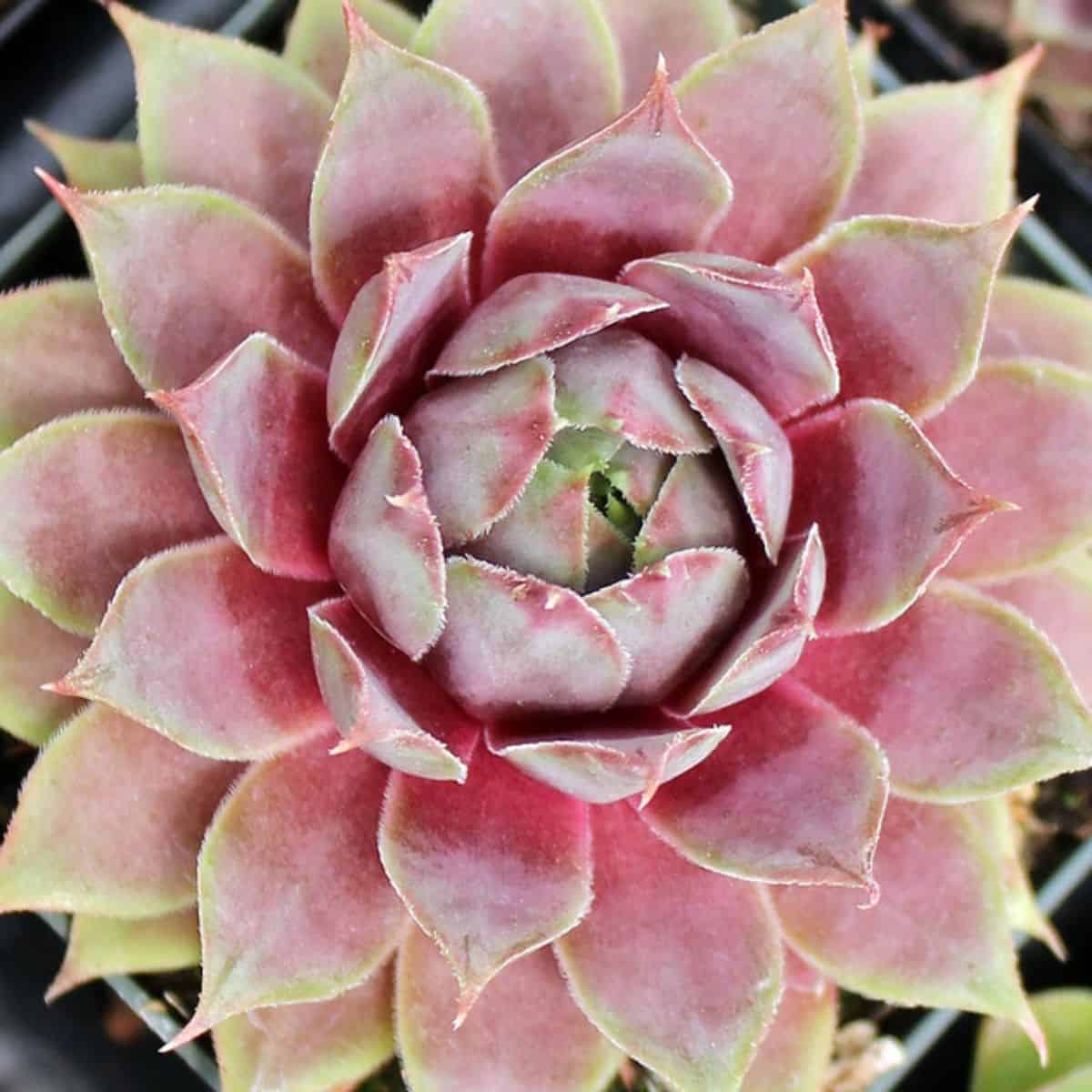
Buy it from:
The Rose Queen is a great addition to any garden thanks to its deep pink centers and light green margins. There are some cillia along the edges of the leaves which end in a sharp point. The intensity of the color will vary based upon the stresses that the plant is facing. Rose Queen has pink blooms that come up from a five inch rosette. This is an easily propagated plant with plenty of offsets!
Sempervivum sp. – Round Robin
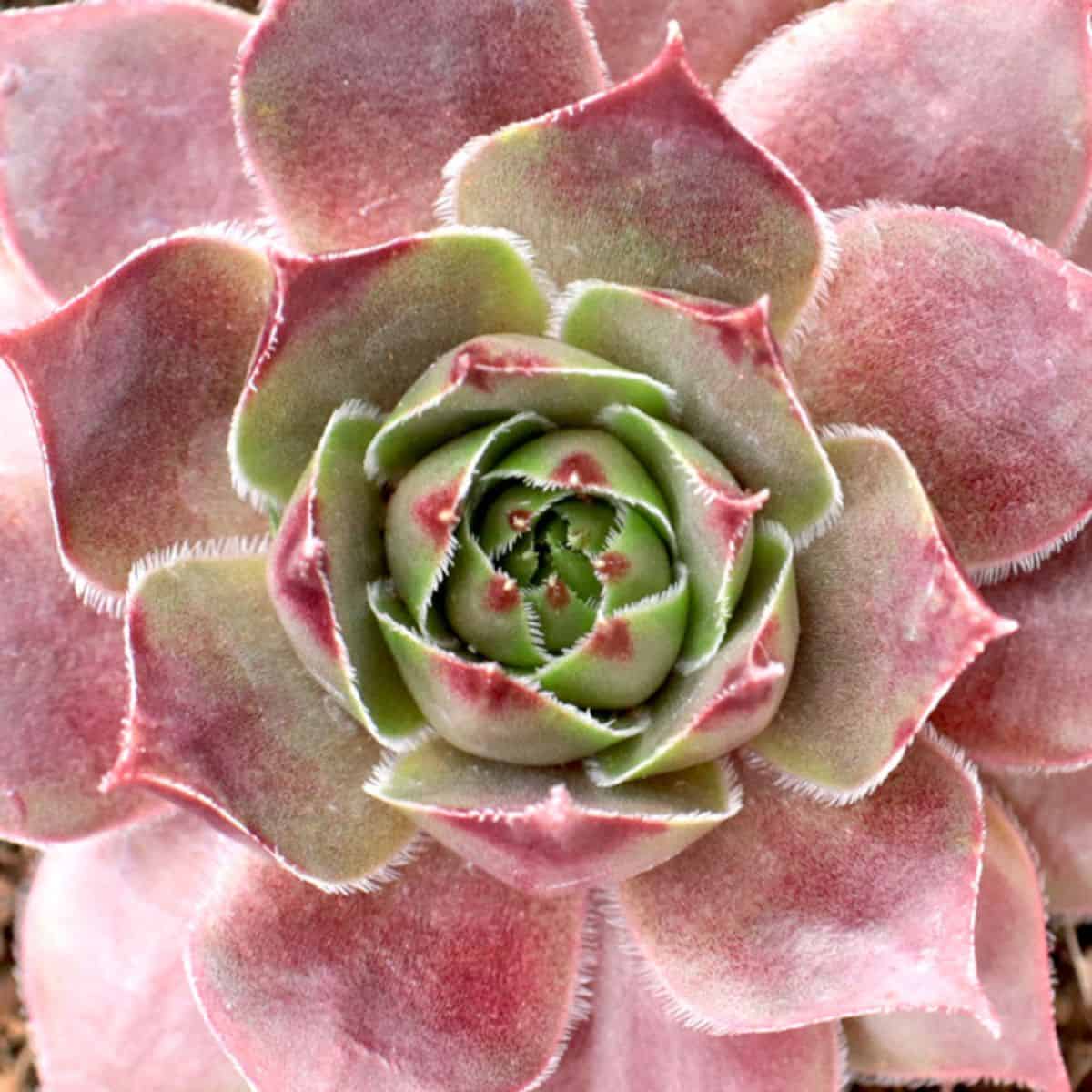
Buy it from:
The Round Robin has elegantly shaped leaves that come up into a gentle point. The tip of each leaf is a deep burgundy pink, and this also includes juvenile leaves as well. The more mature a leaf is, the more burgundy it will turn. Along the margins of the leaves, there are several cillia which give it a slight toothy look. This species is hardy into zone five, and they do have pink blooms. During the summer, Round Robin holds its color. The rosettes reach up to four inches in diameter and ensure that Round Robin has full, but not direct, sun.
Gymnocalycium anistii var.tucavocense
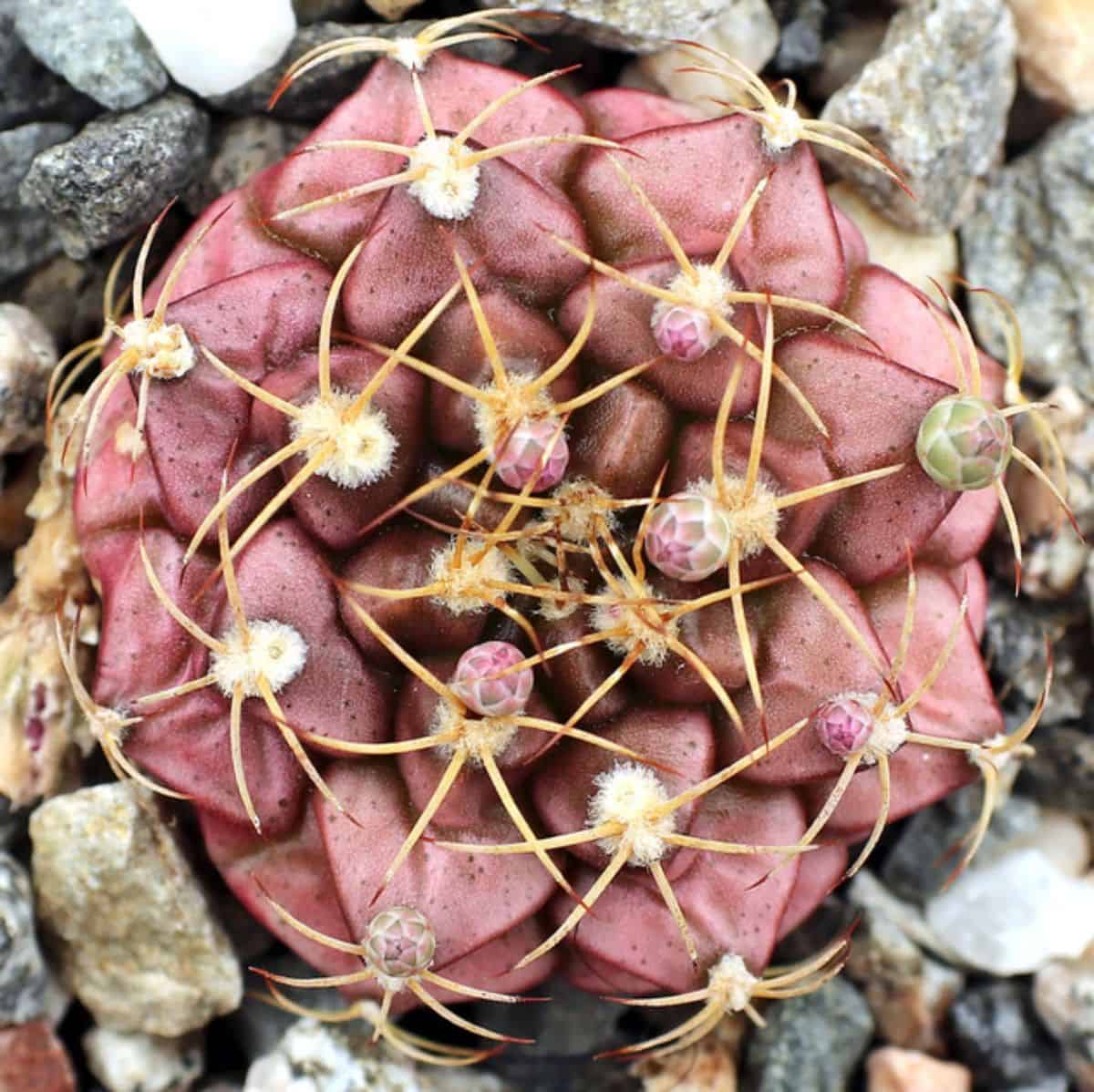
Buy it from:
If you are looking for that special conversation piece, then this species is for you. The tucavocense takes on the appearance of a cacti however it is not. This succulent has a stem that is covered with scale like leaves. The tubercles each have a fuzzy white patch called an areole. Out of this areole six different spines extend out in a circular pattern. The flesh of this succulent is a constant deep magenta pink. They will stay underneath 3 inches tall and are considered a creeping or a low growing succulent. And added specialty of this succulent, is that it also possesses matching light pink blooms. Unlike other succulents, this species is able to bloom even when it is young!
Sempervivum sp. - Magnificum
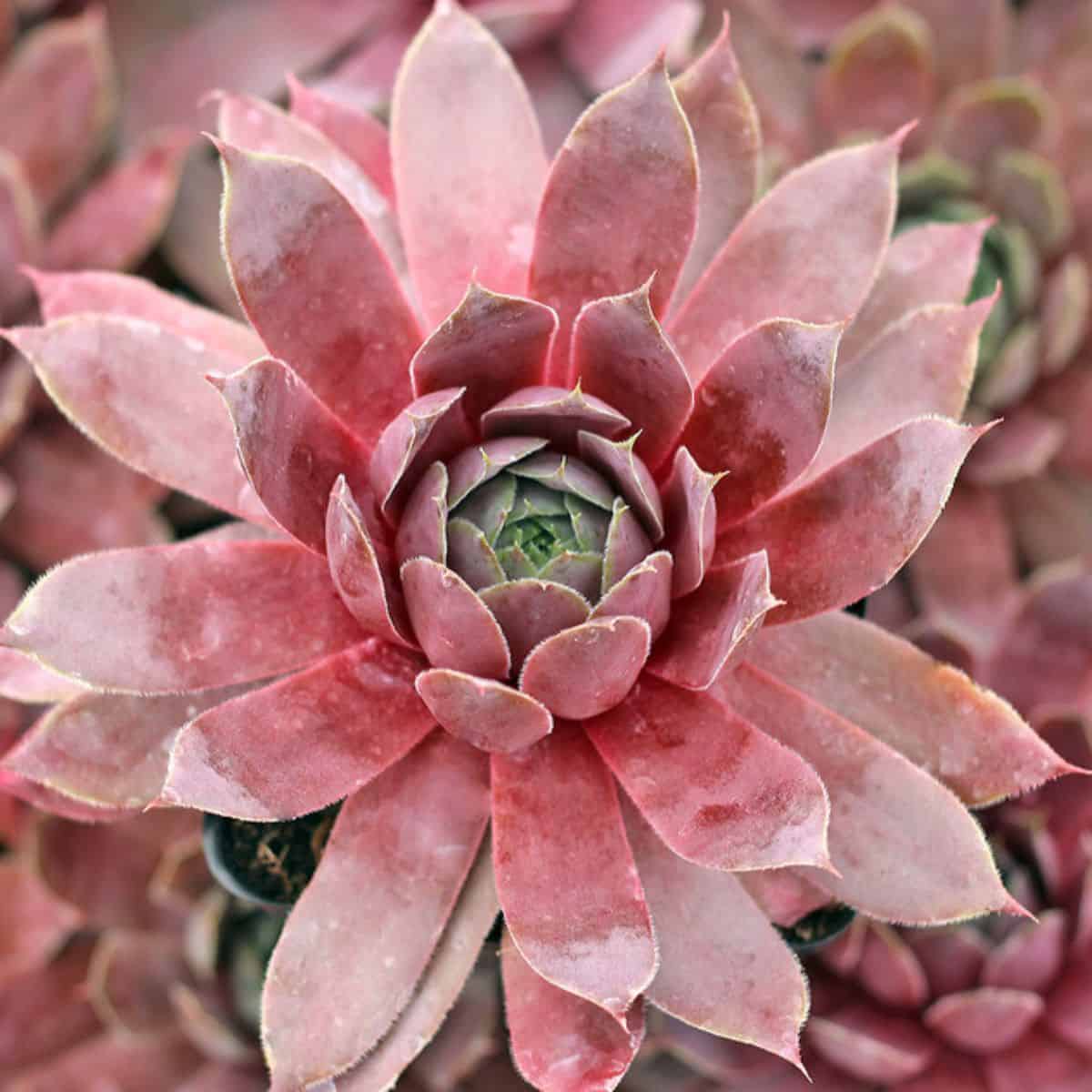
Buy it from:
Another showstopper on this list is the elongated leaves of the Magnificum. The Magnificum changes color throughout the year. When grown indoors or under less stressful conditions, it will maintain a blue-green coloration. Magnificum will begin to take on a light purple coloration during the fall, and it will also start turning pink at various times throughout the year. While young, the elongated leaves tend to flare out dramatically. As the plant grows, the rosette becomes far denser. Make sure you have the space, because rosettes for this species can get up to six inches in diameter.
Sempervivum sp. - Dallas
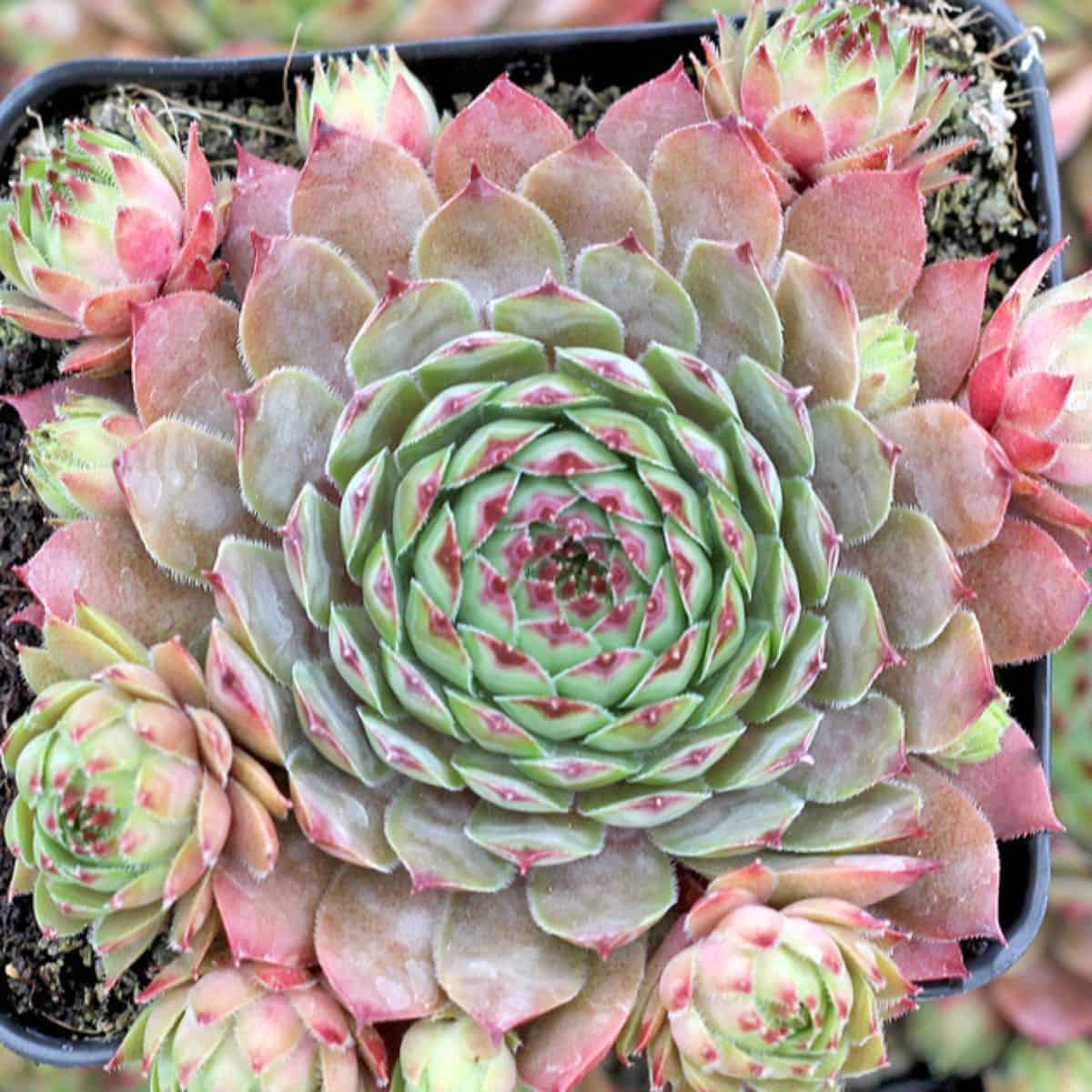
Buy it from:
The Dallas is another sempervivum that changes color throughout the year. The vast majority of the year, it maintains some semblance of pink color. During the colder months, Dallas will start to turn more of a burgundy color. In either season, the leaves are full and the margins are covered with bright white cilia. Towards the center of the rosette, the leaves are a light, almost neon, green with bright pink or burgundy tips. As a leaves mature, farina begins to develop, and pink speckles spread throughout the leaves. This succulent will get up to six inches in diameter and it is a winter dormant species. Watch for their pink blooms during the summer and make sure they get plenty of full sun.
Pleospilos nelii – Royal Flush
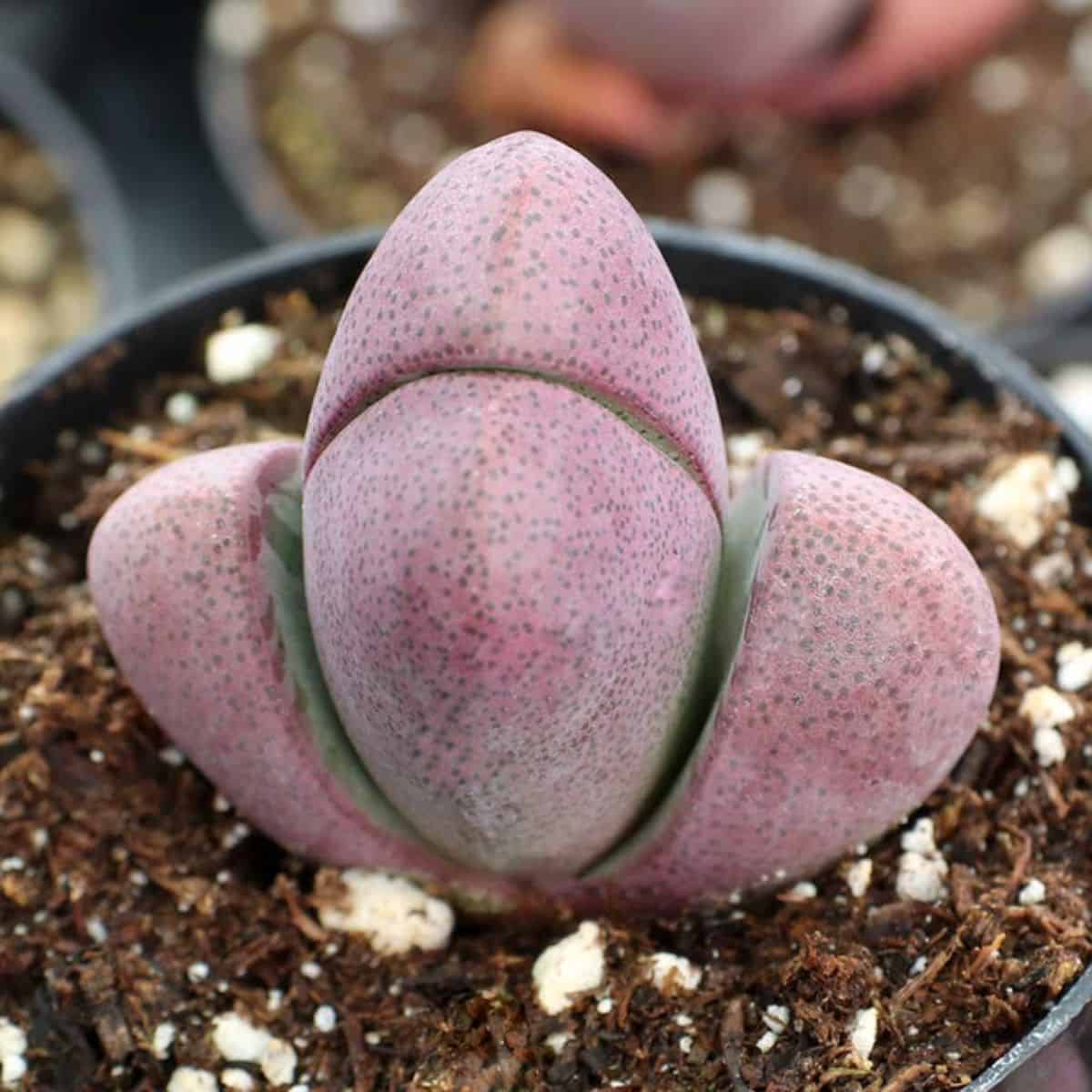
Buy it from:
Split rock species are always fun to have in the garden. Each pair of leaves grows up together, and then they split in order to allow the new set of leaves to come in. This particular species, Royal Flush, is not only pink on the outside, but it also produces bright pink flowers. One of the interesting aspects of the Royal Flush and other split rock species, is that the speckling along their skin is there to help the species hide amongst the rocks that they grow on!
Sempervivum sp. - Centennial
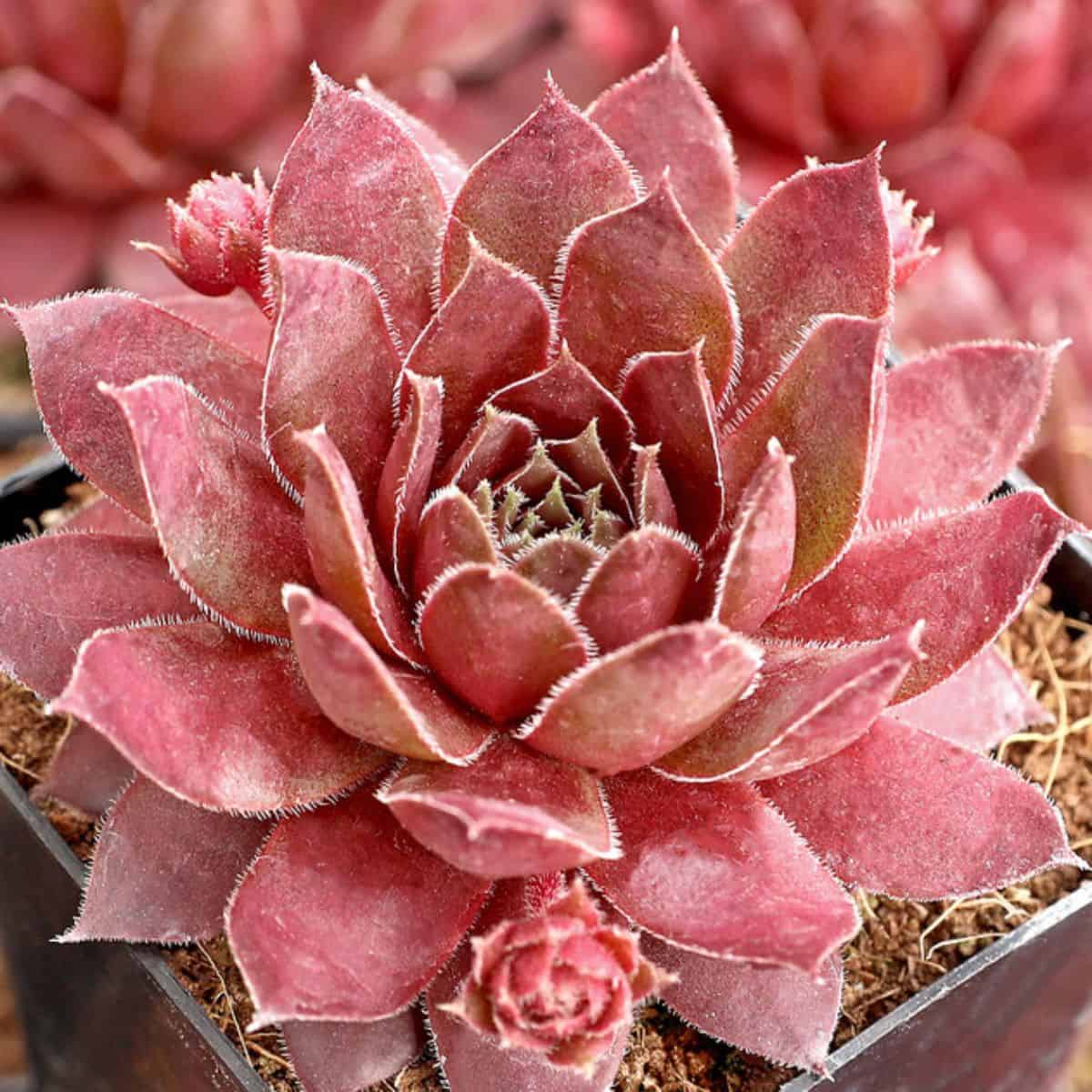
Buy it from:
No list would be complete without the Centennial. Centennial is a dark pink sempervivum with tightly packed rosettes. The leaves take on a flatter shape at the front and a more rounded shape towards the back. The margins are full of small white cilia and this also includes cilia on immature leaves. Whether or not the leaves are mature or immature, they maintain their deep pink color. When there is more shade, or the months begin to get cold, this particular succulent will instead turn green. Rosettes cat get up to eight inches in diameter and they also produce pink blooms.
Sempervivum sp. – Downland Queen
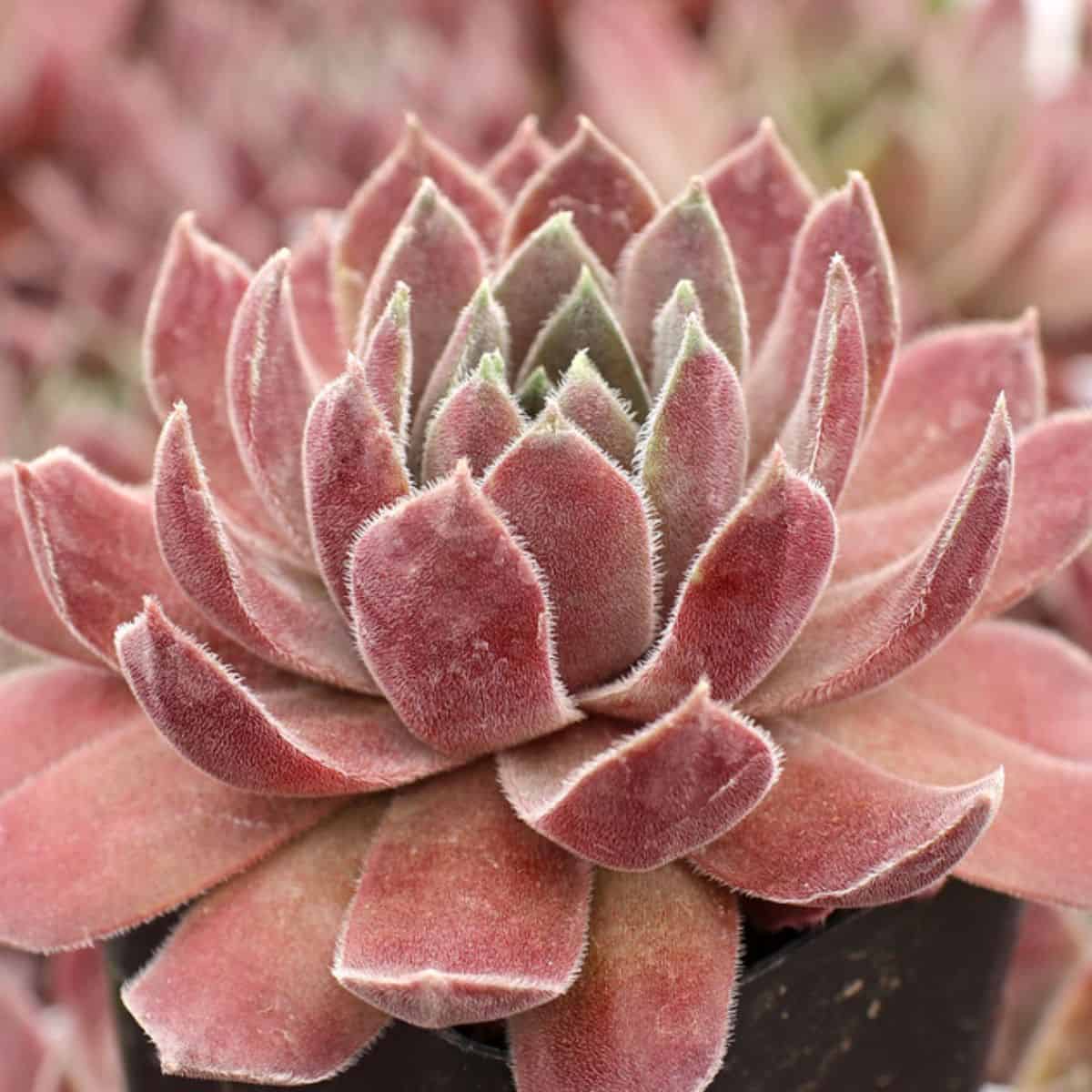
Buy it from:
If a list doesn't include a fuzzy sempervivum then is it truly a list? The Downland Queen is a lighter dusty rose variation on the Centennial. They have an increased amount of cilia along the entire leaf. Both immature and mature leaves turn green at some point of the year, however the brightest pinks tend to appear in the spring and summer when they're also flowering. Watch for pink blooms! This is a smaller rosette that only go up to four inches in diameter. It can change color to darker purples in the later months, however a pinkish tinge will always remain.
Aloe sp. - Oik
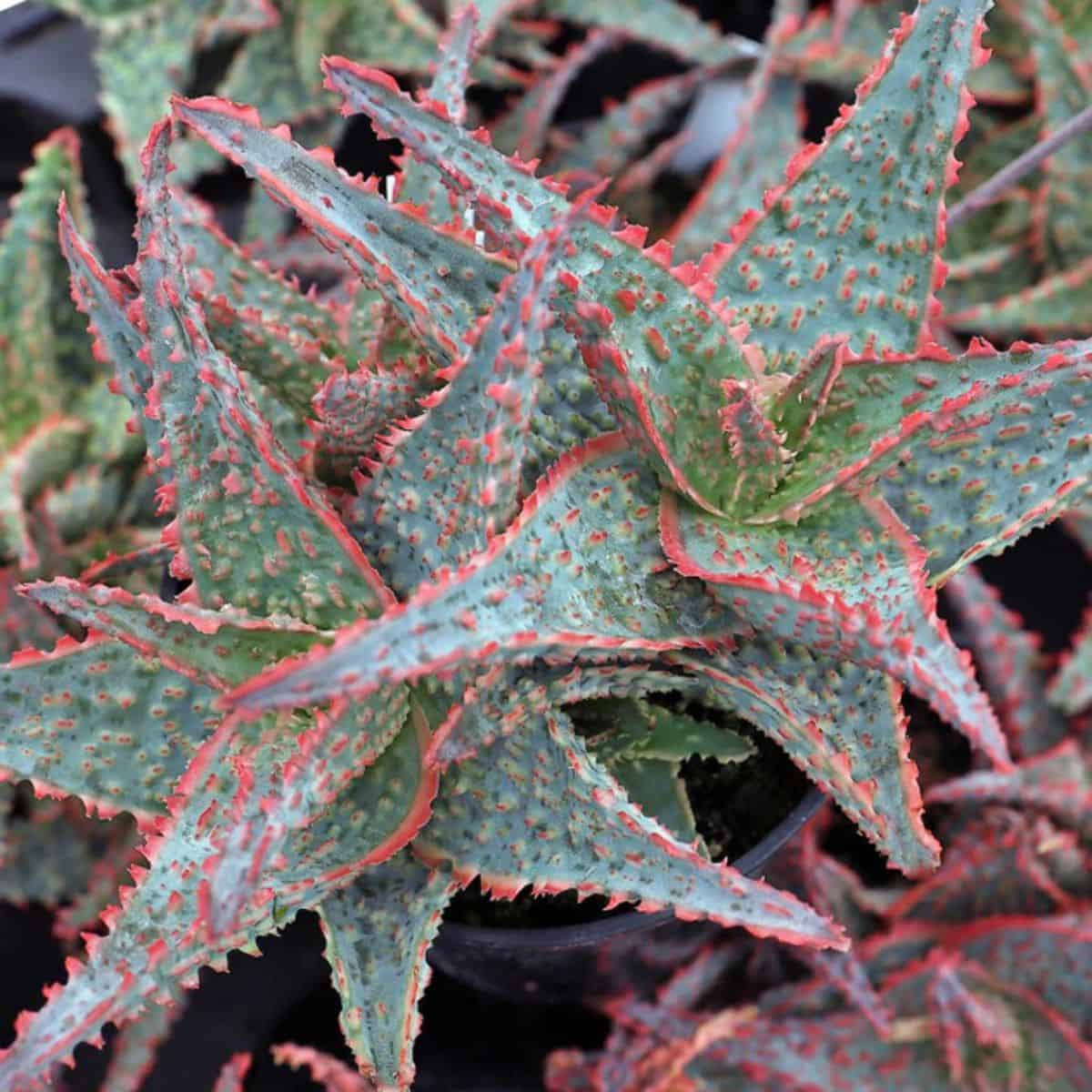
Buy it from:
Oik has a great deal of variation in how intense the pink spots on the leaves are. The Oik tends to grow to about four inches in diameter and it will stay underneath three inches tall. This makes it a very small, dwarf aloe. One of the more interesting facets of this plant, is that the bumps and teeth along the margins and leaves can turn from a hot pink to a darker blue. In order to keep the colors bright, it's best to keep this dwarf aloe in the sun. Avoid direct sun and ensure that there is some sort of filtered sun rather than full rays. In stunning contrast, the blooms are a bright orange that are hard to miss!
Sempervivum sp. - Zulu
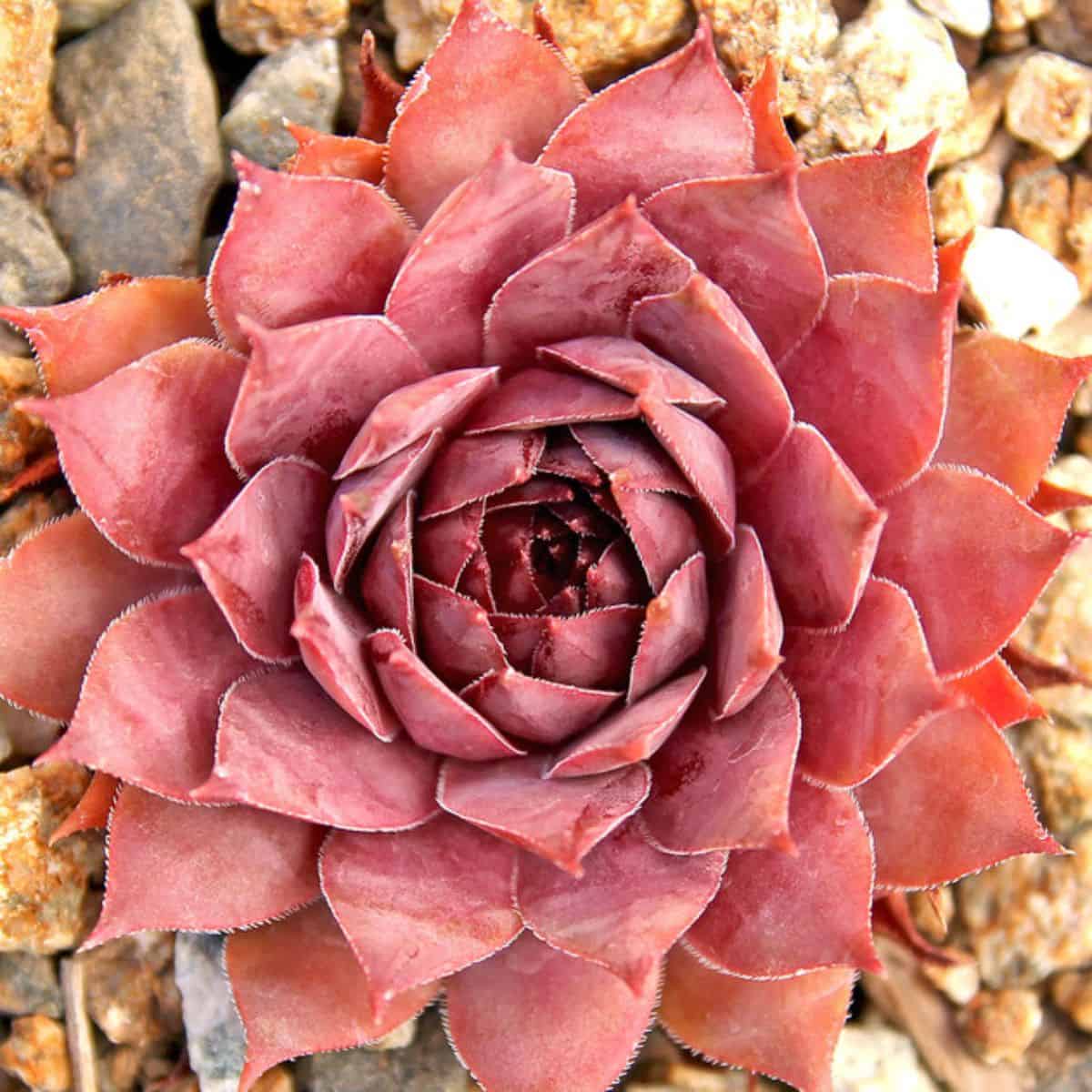
Buy it from:
Zulu is a beautiful addition to any garden. When the colors are most intense, Zulu has a deep rusty rose color. The margins are covered in cilia and the front of the leaves are flat while the back of the leaves are rounded. This gives the traditional semper beebom triangular shape. When not under stressful conditions, this particular species stays a light green with light pink margins and light pink tips. Even younger, juvenile leaves have these pink colored tips. Watch for pink blooms, and be ready to have enough space for a six inch rosette.
Echeveria sp. – Chick Charms Lotus Blossom
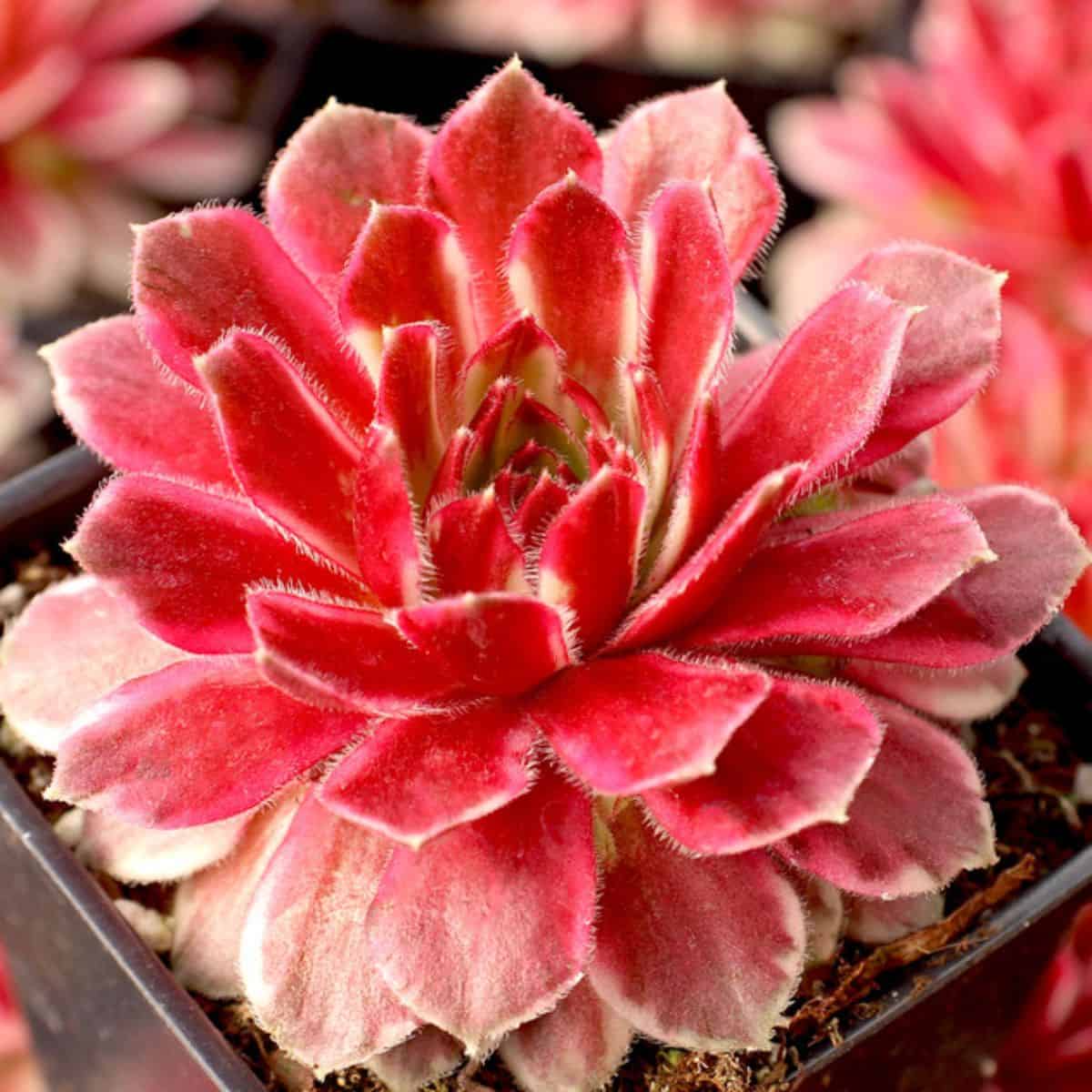
Buy it from:
It's important to highlight the only other designer succulent that we have on this list. The Chick Charms Lotus blossom is an extremely intense pink. Lotus Blossom is a cold hardy plant and it maintains its pinkish color year round: even the blooms are pink! Each of the elongated leaves are covered in long cilia hairs, and the younger, more immature leaves, tend to have a strip of white on either side of the leaf. True to the name, Lotus Blossom indeed looks like a lotus flower. Keep an eye out for any offsets because this sempervivum tends to send off quite a few!
FAQs About Pink Succulents
Understandably, there are still essential things you need to know about pink succulents before you finally decide to grow and take good care of them. Below are the most common questions about pretty pink succulents from our readers.
Are pink succulents real?
This question arises from the fact that you can grow colorful succulents or turn your green succulents into other colors. In truth, there are true pink succulents, such as those included on the list above.
Are pink succulents rare?
Only starting to gain popularity, pink succulents aren’t as rare as new growers might think. Like green and blue succulents, they come in both rare and common varieties.
Why is my pink succulent turning green?
Like other succulents, your pink succulent changes color or turns green, usually because of lack of sunlight. The amount and intensity of light your pink succulents receive usually equals the pink color’s brightness.
That said, you have to make sure you don’t expose them to too much artificial light or sunlight to prevent sunburn. Overwatering your pink succulents can also make them lose their beautiful color.
Where can I buy pink succulents online?
If you like to add these beautiful succulents to your collection, you’ll be glad to know that there are many trustworthy online sellers. You can buy from big retailers like Amazon and Etsy or succulent-specific stores like Leaf & Clay, The Succulent Source, and more.
Add Pretty Pink Succulents to Your Collection Now!
These stunning succulents look great both as centerpieces or as part of a larger collection or design. They're the perfect addition to a spring color palette, but they look great year-round as well. If you're looking to add a splash of color to your succulent collection, maybe it's time to consider a plant in your new favorite color: pink!


KATHLEEN MCCURLEY
I loved the information
can you please tell me where I can purchase:
Echeveria laui
Echeveria ‘Rainbow
they are gorgeous.
sincerely
Kathleen
Terri Bauer
Google it! I found them listed on Etsy but if you live near a 'nicer' greenhouse (not the usual box store) you can probably find them.